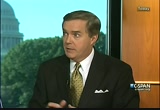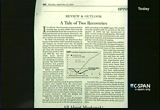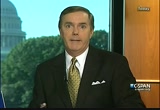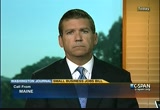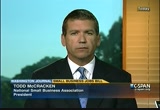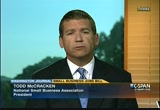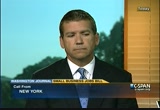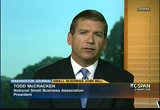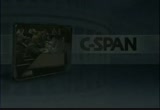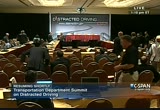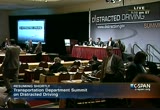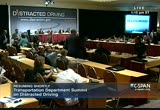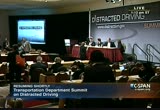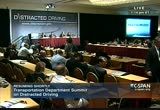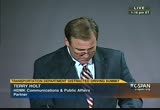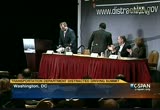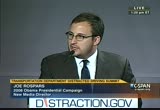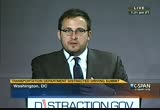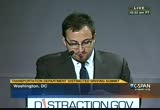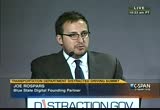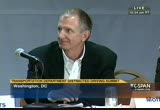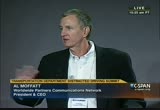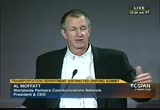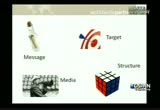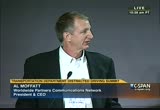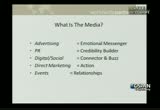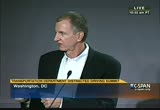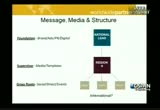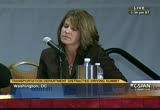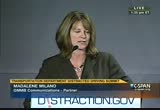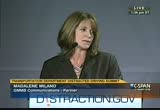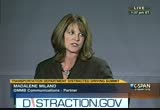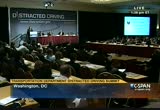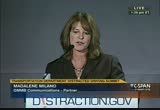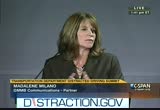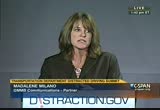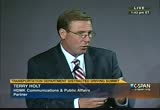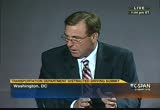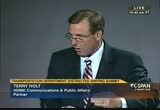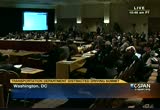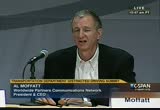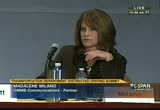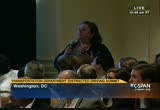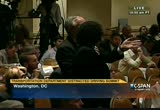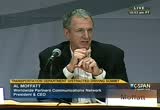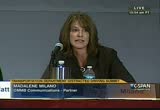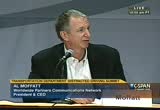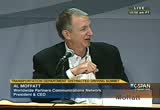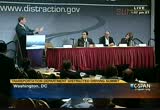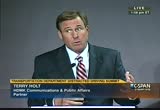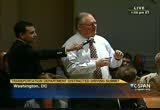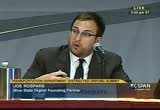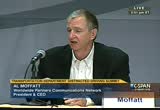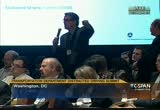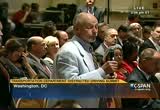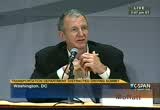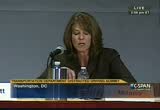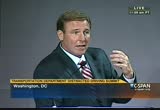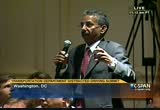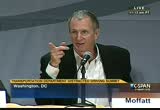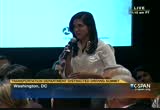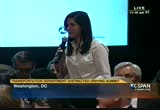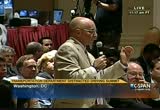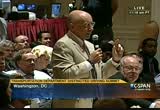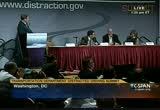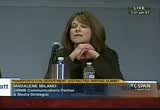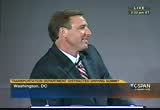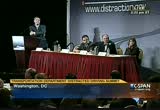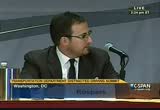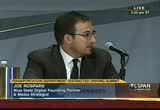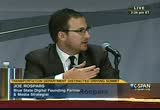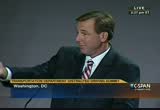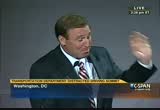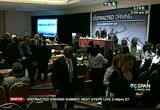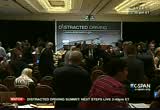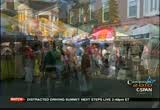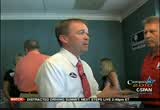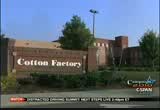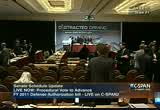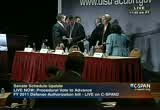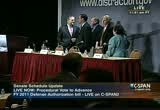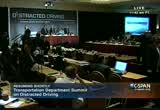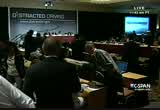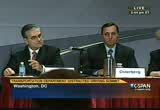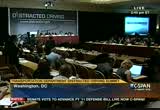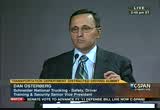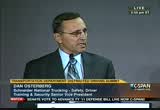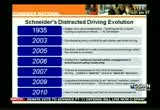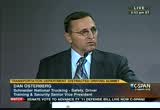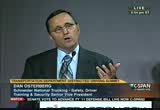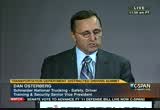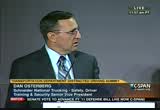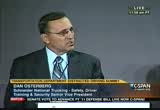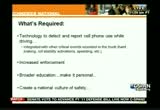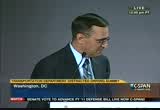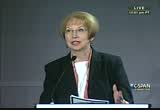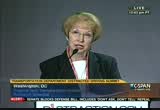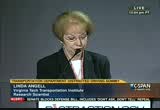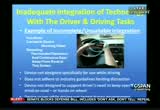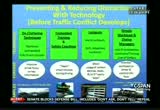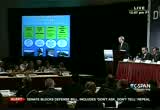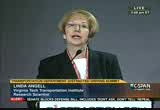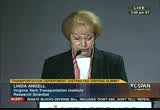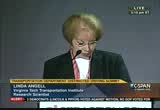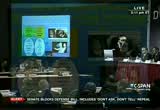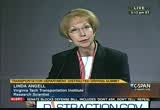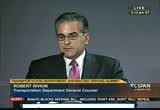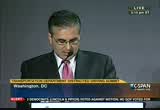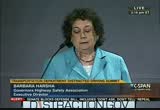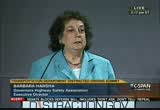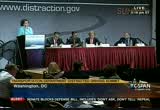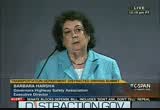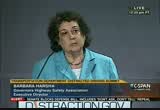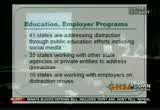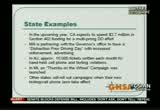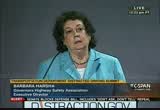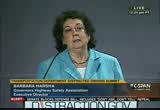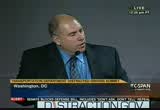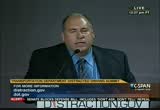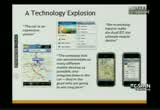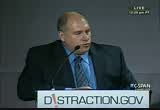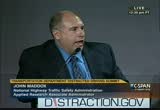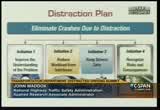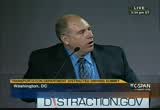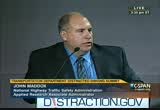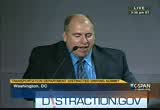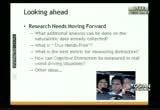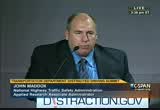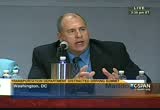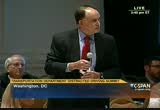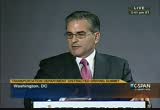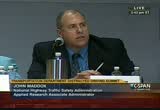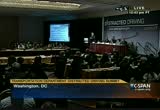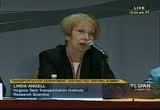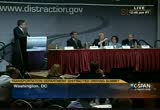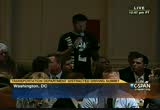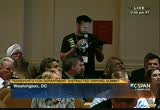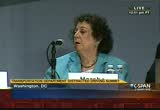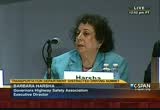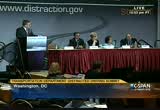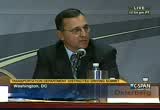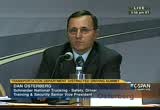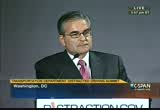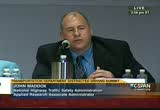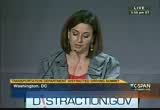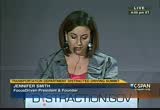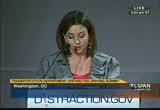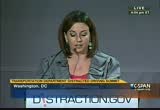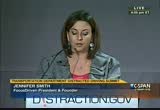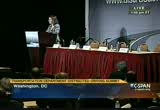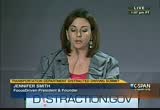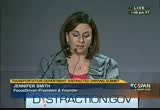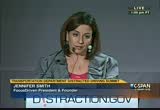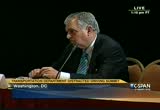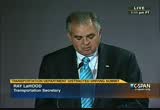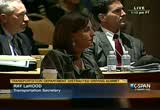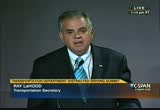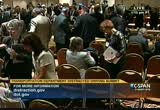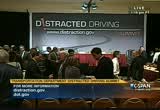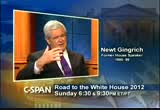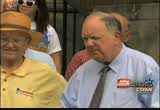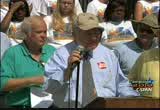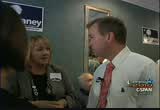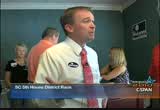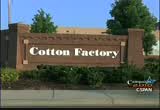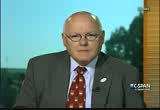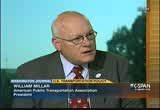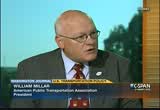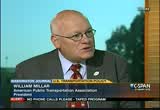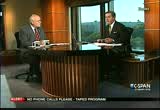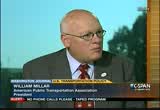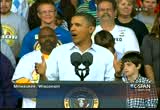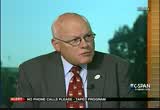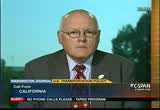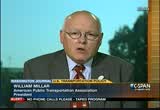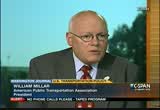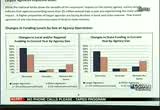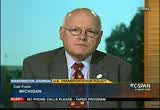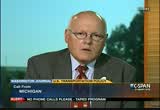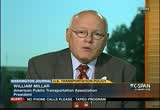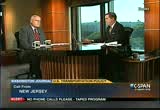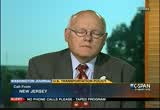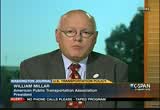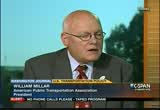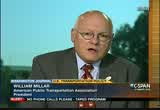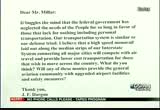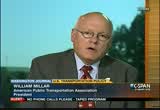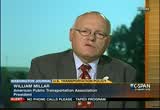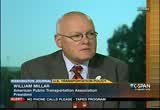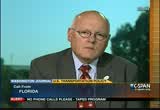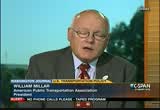tv U.S. House of Representatives CSPAN September 21, 2010 1:00pm-5:00pm EDT
1:00 pm
your mortgage is worth more than your home's value, you will not spend money. if he lost investment, you will not pull back -- you will pull back spending. for the people who have jobs and don't want to spend what will t them to spend more money? guest: it comes back to confidence in the economy. if the house price starts going up again, will begin to spend some more money. but one of the biggest single factor years i think is the sense that we are and they don't have to be quite as wary about -- worried about losing their jobs or their spouse losing their job as before. host: let me go back to the "wall street journal" editorial.
1:01 pm
no but competing explanations for this undeniably disappointing performance of the economy. the fiscal stimulus saved the day and we need more of it. our view is the hyperkinetic government policies have done more harm than good, leading to uncertainty and higher cost that have undermined businesses and consumer confidence and slowed the country's economy is otherwise natural recuperative powers. agree or disagree? guest: on the one hand, stimulus does cause additional spending and economic growth. but all of the attention and worked getting these things in place gets to the point that i was making before, which in some ways hurts people's confidence at some level. then it just adds to people's worries and a sense that no one is really grappling with this problem as we go along.
1:02 pm
host: we are talking to todd mccracken, president of the national small business association. maine, on the line for republicans. caller: i just sold my small businesses here in maine. host: what was your business? caller: movie theater. host: why did you sell it? caller: because i am extremely concerned about what the future holds. the economists were screing at the top of their lungs when we had this housing bubble, that we have the bubble that was going to go bust. they were ignored and laughed at. ridiculed. we now have a new bubble. we transfer the toxic debt to the public sector. with the treasury bubbled. that will go must eventually and it will lead to double-digit inflation. how is my business colleges survivor any small business survive once consumer discretionary spending is tapped
1:03 pm
out spending all their money on food, energy, just the basic necessities of life. just a bubble after bubble after bubble, and we have not stopped. the federal reserve is just pumping money into the system and a bubble is going to go burst. it will bust the bentley. host: how long did you own the movie theater? caller: 14 years. host: how many employees? caller: four people. which i loved. i did not sell it lightly. but i do not see how we get out of this without a lot of pain, or a lot me pain than if we do the right thing which is to save money, invest, and produce. we can't just keep borrowing and spending money. 8 so did you have trouble selling the business? caller: the business is doing pretty well. if i base my decision on the way things are going now i would not have sold. i am concerned a year from now
1:04 pm
or two years from now. looking to the future. host: we will get a response. guest: i think the situation you described, while on the one hand, you sold your business, but i think the same kind of thinking for people keeping their businesses is one of the factors causing people not to hire and causing people to -- at some level, your point is exactly right, that we cannot go deeper in debt. it just creates a different kind of ball. but the reality is i think a recession we are in right now is in some ways growing out of the bubble we were in because people are to a gater degree saving again. that saving that they are doing is going to help us in the future as we reinvest and
1:05 pm
stabilize and grow out of this. host: you do get more information logging onto nsba.b is -- jeff from florida. good morning. caller: i have a questn and a concern. theatriot long for veterans. wondering if there is any activity for met -- patriot loan. guest: in terms of? caller: loaning down to usf veterans. host: you need to start business? caller: to gain some monetary to help us of parrot guest: as i am sure you know, there are a number of programs through the re sba to help veterans.
1:06 pm
senator kerry is to be chairman of the commanding, and was a lead in veterans business issues and did put together that bill. i have to go back and see where things stand with passage right now. but we certainly have been supportive of efforts to get more cash into the hands of both the veterans businesses and all small businesses. host: upstate, new york -- upstate new york, binghamton. caller: i just wanted to say that i am amazed at the ignorance of this administration. you are postulating now that small business loans of up like that, going through the banks, who are not lending and a coinue not lending. they have been not lending for the past year and a half or even better, right? the other thing is the fact that he has to pay for the new obama
1:07 pm
care, and it is frightening because you don't know what will happen after january. i have seen my health care policies go up 100% or 150% in the meantime. incentives. weave seen over in china where they are making the ipod and the other various technological things, that they have 300,000 people. they get a cheaper rate. there should be a tiff on the products sold into the united states or create an incentive to have the companies to some of the manufacturing back here and create jobs. but there is such a plethora of obstacles that no creativity is fair and balanced anymore. that is all i have to say. thank you. guest: you have a lot of things in there. i think you are right on most of them. the credit stuff, you are right, banks have not been lending. the thing at has been a little encouraging -- banks cannot additional help unless
1:08 pm
they increase their lending to small companies. very unlike tarp in that sense, in which they did not increase their lending. the stuff in this new small- business bill, directed a smaller community banks and they did not get anything unless the increase their lending to small companies. host: one of the dichotomies pointed out on the front page of "the washington post, neil whirlwind indicates the crisis may be over, referring to the request and -- recession. the stock market has been up, but the frustration over the slow recovery remains. guest: i think that is a good synopsis of where we are economically. that the financial sector, that the investors seem to be doing better but it has not really translated to main street yet, the small businesses and every day workers. that and turn translates to political difficulties. .
1:09 pm
h., tod >> i really underestimated how big the job was. i had been the republican minority whip. i jumped to speaker overnight. and from sort of a minority party that nobody felt was going to be in power to leading a wave of 9 million additional votes in 1994 as the biggest one-party increase in off-year american history. >> newt gingrich on his tenure as house speaker, the state of american politics today, and a possible 2012 presidential bid. sunday on c-span. >> the c-span video library is a great research to see what has happened in washington. find the most recent events we have covered, the ones most watched and most share, all free. this used in video library. watch what you want, when you
1:10 pm
want. >> the c-span networks, we provide coverage of politics, public affairs, nonfiction books, and american history. it is all available to you on television, radio, online, and on social media networking sites. and find our constant any time through c-span video library. and retakes he's been on the road. bringing a resources t your community. it is washington your way, the c-span networks. now available in more than 100 million homes. cree to buy cable, provided as a public service. we return now to our live daylong coverage from the 2010 distracted driving summit taking place here in washington. attendees just moving back into when this resumes, there will be a look at the use of communications and media to combat distracted dry feet. it should get underway in just a moment here live on c-span. after a short break about 2:30
1:11 pm
1:14 pm
>> again, we're bringing you live coverage of the 2010 distracted driving summit. coming up next, a panel on the use of communications and media to combat this threat to try to get up the "washington post" reporting this news from this conference. the new battleground between advancing technology and i wasted the emerged today when the u.s. transportation secretary scolded the auto industry for turning cars and to entertain visitors. in recent days and weeks, we have seen news stories about carmakers adding technology to vehicles that led drivers update facebook, surf the web, i do other things instead of driving safely, he said. they are distractions. he kicked off his second major conference on distracted driving with the announcement that i end-state truckdrivers that drive with hazardous waste will be banned from sending text messages. the law private employers to adopt restrictions on cell phone
1:16 pm
>> the afternoon, everybody. i hope everyone enjoyed their box lunch. not many vegetarians in the room. i get stuck with the vegetarian meal as i arrived a few minutes late. i am the moderator for this next panel. like our panelists, i am a communicator. i am is a partner in the firm hdmk, a strategic communications firm in town. we run campaigns and provide people with real time it buys about how to deal with the media and their communications strategies. -- we provide real-time advice about how to deal with the media. i took this from secretary lahood's website, so i will
1:17 pm
complement him by stealing his lines. this summit today is intended to bring together transportation experts, said the advocates, law enforcement officials, industry representatives, academic researchers, and destructive driving victims. we have had a busy morning. thank you for coming. i do not think there's any question about the level of leadership and engagement by this group. i have talked to a lot of people who believe passionately in solving this problem. and so for this group here, this panel, the challenge would be fairly straightforward. how do we, as a community, transit all that energy and enthusiasm into a compelling communications strategy that educates people and change his behavior? we have hundreds of laws that are being proposed, as many as 90% of the american public
1:18 pm
agrees that distracted driving is dangerous. the facts are compelling. people died. one in five crashes -- fatal crashes involves destructive drive iing. national safety council has a study that, in effect, shows this is your brain. and then, this is your brain on suspected driving. even oprah6; is involved. so what is the problem, right? the problem is this in a nutshell. i am not giving up my device. no way. and i am not letting my wife leave her phone at home, because i need to find her. i have a security blanket in knowing where she is. it is part of our dna, and whether it is consequential and important or trivial and the silly, these are in our lives for all time. right?
1:19 pm
we all know this. hands full. we have three distinguished experts in three distinct fields of communications and media strategy. and we're going to start off today by introducing joe rospars, the founder of the firm blue state digital, a leader in online advocacy and social media. he serves as the new media director for barack obama's presidential campaign, where he oversaw all online]iftder>oiñ'if this unprecedented fund-raising, communications, and grass-roots mobilization effort. prior to the campaign, he led his firm's work with governor howard dean of the democratic national committee. he was also a writer and strategist in new media for howard dean's presidential campaign. he holds a bachelor's degree in political science at georgetown university. i will turn it over to joe.
1:20 pm
[applause] q÷>> thanks very much. so i drew the card to talk of a social media here for everybody, and there is a lot of mystery sometimes around how organizations and causes should deal with social media. i am here to tell you that whether you are a heavy user or a never user of twitter or facebook or online organization platforms, that was never part of this movement that you are in, you have something that you can do to wrack your head around and make use of it for you. because there are hungry people other looking to participate on this issue and in the cause. so if we could get the slide going. my take away here for you, if there is anything you can remember about the social media, is that it is not just the communications platform to push out the message. it is not a fancy place where
1:21 pm
all the kids are sort of organizing online. it is a very concrete organizing medium for you, whether you are a big user are not. a couple of tips to take away with you as you go back to the grassroots organizations are the different parts of the movement that you are in. -zñithe first is the authentic. again, if you're on social media or if your organization or community group is advocating on this issue, speak in a human voice. tell the stories, which are the most powerful component of turning people around on this issue and getting passionate about it and advocating for. that authenticity will drive the involvement in the people come back to you. two would-be build relationships with those people social media and the web, when it comes to organizing, is not very different from organizing in a church basement or any other kind of community gathering. people want to have a relationship with their leaders and their organizations, so that
1:22 pm
called in response, the ability to have the back-and-forth conversation with the people you're looking to mobilize, is key. the third one is,ñ?f:r are mere leaders with the recourse -- resources. if he stumbled into this movement because something that happened in your life, where it -- what were the things you went to look for straightaway. whether the things the people who discover this on the first day need to know about? people will take action when the first learned it there's a low barrier to entry in the can get involved, but they will take secondary action and become leaders if you are the mine a very easy and simple way to do it. that conversation is key. be specific. let people know exactly what the challenges are at this point in time. getting the word is out there about the particular legislative ballot -- battles regulatory battles, but also about how exactly they get involved, where they live.
1:23 pm
be as specific as possible so that people know that if they have five minutes to get to the cause or something to do, whether it is on facebook or twitter are signing up for an e- mail address, they need to know what is happening to them and how they can make an impact. be everywhere. obviously, they're great sites out there were people consigned to be part of the movement, but you want to be on twitter or facebook, wherever you think people might go with mr. to discover this issue, including groups and forums on line, putting out the bait out there so people can know that there is energy and leadership on this issue. finally, measure everything. when you send out an e-mail to a small group list, look at how many clicks' come back. look at how many people reply to the message. look at how many people take the action that you are pushing the same thing. if you send out a twitter message opposed to something, looked every bit of measurement of what is going on. the same thing for people coming to a website. if someone is trying to organize
1:24 pm
in a particular state to get people to sign up to advocate for a new law, a measure how many people come to the website and how many are signing up for your e-mail, and perhaps you need to get that sign up higher. that is the captive audience you want to have with people interested in because. whether it is e-mail, twitter, facebook, social media, taking in organizing approach, lowering the barriers of entry for people to get involved in and telling that passionate story is what makes sense. thank you very much. [applause] >> gravity. i have got five minutes. no. thank you, joe. i am going to join his twitter because that was fast enough that i can follow it. now we're going to hear from the president of worldwide partners. the world's largest network of
1:25 pm
independent advertising agencies. as president and ceo, he leads the growth and strategic direction of the company on behalf of his partner agencies. over the last five years, worldwide partners as grown over 50% and now is over 20 international accounts. al has guided national and international advertising programs for a long list of major companies. he is a thought leader in marketing and business and published in marketing and business publications worldwide on topics ranging from the global economy to business management and advertising. al. [applause] >> thank you, everyone. i really appreciate being here. it is an honor. i wanted to the one question first that is on your mind. i am in advertising. what is the one question you think i get asked more than anything else? it is all true.
1:26 pm
"mad men," it is all true. [laughter] i missed the three martini lunch though. interesting enough, let me start by asking a quick question. who here has been to see a motivational speaker? someone like tony robins, an investment adviser, could be a great sermon at church, could be a great political speaker. we have that energy and that jews. you know, you're in that room. you feel that passion. just like you feel in that room. you all did it in to this meeting and this cause. that is the great thing. you're on the leading edge of this issue, no doubt about it. the bad news is the minute you walk out the store, guess what happens -- not only does your juice start to reduce a little bit, but they do not have that juice.
1:27 pm
you got on ninth street and go, my god, what happened to the juice? this is stupid. i cannot believe they would do this. look at all these idiots text messaging and doing make up. they did not have the juice. our mission is to get yours out that door and on to the people on the street. not an easy thing to do. so at the risk of being very, very, very rudimentary, almost like a drummer wears a month starting with a guitar chords, i want to kind of the construct this a little bit and go back to basics. as my father always said to me, assumption -- to do not want to necessarily assume it is all about advertising and marketing, based on your comments over lunch, you certainly do. just like all people. right, thank you. we can go to the next slide. we have already seen the children crying in the back of the car. four areas of want to touch on. the messaging. what are we going to tell
1:28 pm
people? who are we going to talk to? what is the structure we're going to put all of this in? and how are we going to use the media? joe talked about this. it has gone more complicated over the past several years. next two really, what has distracted driving? good question, right? again, the assumption as we all know what distracted driving is. do you read the press releases? you see distracted driving. we have an understanding what it is. people loss of of this room tonight. everyone has a different definition, as we saw in the psa's. i think you know where i am going with this. let's define what distracted driving means to people. is it wireless consumer electronics? is it dealing with the kids in the back seat? is it dealing with my own brain.
1:29 pm
if you're like me, i swear to god, sometimes i get from point a to point b and have no idea how because i am deep in thought. i tend to drive and think. not a very good combination in some cases. so we need to define with destructive drug means. it is all to leak -- it is ultimately important. we did not want to assume the people know what we're talking about. because we will not be relevant. most importantly, we will not be actionable. so let's define what it is we're talking about. [cell phone rings] >> exactly. that is my point exactly. distracted meeting. who knew? who is the target? depending on where you live, their major metropolitan areas where it is everyone. i live in the san francisco bay area. it is worse in washington, d.c., or new york. it is fantastic.
1:30 pm
you can watch this happen right before your eyes. so you saw this over lunch today. the interesting thing about targeting is it really does not matter what i think. it matters what the target things. the game by like to play with clients is if you have $1 to spend, you would suspended? but you say, look at this, look all these people. the soccer moms, parents, college students, retirees. it is everyone. you're right. it is everyone. but you have $1 to spend. who are you going to spend it against? that is really important. try to answer one question, who is the target audience? it drives literally everything. it draws the budget, the messages, the media, and the time. the temptation is, like with any vision or like my 17-year-old daughter that is about to go to college, or so she thinks, she
1:31 pm
wants to get into an acting career. real quick, i do not want to go to college. i just want to go, go, go. slowdown. you'll get there. and we will give the with the target audience. so my kind of fatherly advice to you would be take the time. take off one audience at a time. and no over the course of three, five, 17 years, you'll get to everyone. so take your time and do not bite off more than you can issue to begin with. what is the media? if i ask you guys the question 10 years ago, you would have said, ok, it is a little billboard, a little tv, a little prayer and, maybe an outdoor board. that is it. but as joe has alluded to and as matalin will talk to in a moment, it is really messy. so what is the media? i would say to you, do not go down that hold. just be very, very cognizant that keep it simple. so these are some brought things
1:32 pm
to think about. advertising is a general sense is, the emotional content. what you saw in that room was a visceral reaction. whether you like it or not, there is a visceral reaction that advertising can give to you. you cannot explain how it works. it hones in on who is your talking to. and it is relevant and meaningful to them. public relations has become increasingly more complex because it is starting to emerge as social media very much so. the two have become very much intertwined. for social media and public relations companies are almost one now. but public relations gives you a third party credibility. it is not just the media anymore. it is the consumer's going in. how many of you go on yelp orchard adviser? this is what i like about that hotel or that restaurant. that is social media. obviously, you have digital marking coming events, and so on. or direct marketing.
1:33 pm
these help you get engaged in make the commitment. when you get in marketing, you are saying is ok. i opted into this. when you do any good on the local level, that helps you put the relationship in context. so you start to internalize and personalize your feelings and as a visual notion with the brand. all these things can work together. very rudimentary. this is the structure. the good news, you guys have a great structure in place. no different than cooperation. think of yourself like mcdonald's or even a commodity like the national beef industry council, whose role as many years was to get people to eat more beef. this does at the high level or the messaging and strategy takes place. it starts to drift down. so is the bottom-up in the top- down sort of mechanism. you have a great structure in place to make a difference comments of the media makes work hand-in-hand with each other.
1:34 pm
the of the day, yet the messaging, the media, the structure, and the target audience. and i am hopeful that if you're patient and persistent that we will realize the vision. if you ask me to years from now, hindsight is 20/20, but i want to have that hindsight. i want to stand appearance a, remember 2010 when we are struggling with this issue, and now we have assumed in a way the dumbest thing in the world. i cannot believe a text message to talk while i was driving. that was stupid, dangerous, and it was harmful. that is the vision i have the these are tools to help you get there. thank you. [applause] >> thanks that was the last word before we open that up to you in your input in this conversation we're having. i would like to introduce madalene milano from gmmb.
1:35 pm
she has been gm hasmb for more than 22 years. since joining the firm in 1994, she has provided the strategic communications advice, including for her firm's client, the campaign for tobacco-free kits. currently, she provides strategic counsel and oversees the campaign's national and state advertising initiatives, and at reducing tobacco marketing to children. her credentials are also particularly strong in highway safety, having been critical work in positioning mothers against drunk driving and the air bag in seat safety belt campaign. please join us. [applause] >> rolls right off the tongue. tristate over a decade. he did afternoon. i guess if social media is the
1:36 pm
shiny new object and advertising is the fizzle, i would say that media is old reliable. i said that was affection because it is the one of the most efficient and reliable tools we have in our communications tool box. so let's go over the basics. earn media is getting the news media to cover story in your message on your terms. the advantages to earn media are that it is generally less paid advertising, generally more credible because it is coming through an objective third party now. that is all -- not always the case anymore. for the most part, traditionally, that is how to spend. traditionally, it is easy to target the audiences. you're able to approach the media outlet that you are frequenting. all covered does not equal. there's good coverage and that coverage. it does not mean you're getting a bad story necessarily. but the disadvantage for earned media is that it is difficult to control the message and placement.
1:37 pm
for a repeated story, it is hard to maintain interest. that is what we're talking about this today. earned media is definitely not free. i love when people say free media. it is not free. it takes resources, whether it is your time, and they're out of pocket costs as well involved with reaching out to the media. but at the dallas would tell you today that, you know, the most effective tool is an integrated approach that would have social media, paid advertising, and earned a media. if you just never the media, the most effective ways to plan for it as an ongoing throughout the year. in the will talk more about that in a few minutes. something that is important to note at this point and i felt very strongly about is that you should really consider media as your partners. and i do not think everybody does. the media play a key role in
1:38 pm
helping us solve some critical social issues. they have been our partners in a seatbelt use and the decrease in drive began this country, and they have been highly effective -- i know that when i worked on the air bag issue back in the mid-1990s, it was a coalition with pozzo in insurance industry and supply makers and the government. and we were just hit with a constant barrage of crisis media. and we figured out how to use that to our advantage in use the crisis five kind of environment to the regency on the issue and use it as teachable moments to get parents to move their kids into the back seat. and it worked very effectively. at the time, earned media really was our only tool. there is no such thing as social media, and we do not have paid advertising as part of that campaign. so it is an important thing about media as your partner.
1:39 pm
your objective is to tell your story to build support for your issue. tell the story and provide timely and interesting information. of course, your audience is your target and the reporter is an intermediary. it is a brand and as you develop your story, you do that with the reporter in mind, making their job easier. you think about the desired outreach, the desired outcome, you target audience. what is the message in what is the story? when i say story, i do not mean one single element. i am talking about the overarching message in campaigns. kraft your message using key message points. did not get beyond three or four. city want to continually repeat. and do your homework about the reporters. make a plan that you are reaching out to the folks who care about these issues, and you can build relationships with
1:40 pm
over the long term. so how do we generate earned media? kenny go back to the second slide? it is a little out of order. i do not know if any of you saw this, but it was a put -- pretty clever appeal by a local church, and i do not think it was their intent, but this made it around the internet pretty quickly. i saw mentioned on cnn. so this is a little precursor. these are some of the obvious and traditional forms of generating attention. news conferences, we should note, with dwindling staff and reporters, you want to hold a news conference if you have something visually to show it to tell. it is for hard news, breaking news. it is not as much used anymore because it is hard to get reporters to come and cover an actual event. more and more we're using media briefings and deskside briefings
1:41 pm
or one-on-one, editorial board meetings. in doing conference calls and video conferencing and web conferences with reporters so you're being sensitive to the time. gimmicks, theaters, the power of a good story. these are all important for getting attention. these are getting attention more and more these days. sustaining coverage. it is really important that you're making a plan, a year round plants, developing a plan with multiple tactics and techniques to get your story out. this is an issue that has a lot of legs. there's a lot of interesting elements and components to it. employer rhythm, what we call peaks and valleys. you cannot talk to reporters every day about the same issues. but you can get them to pay attention throughout the year. put a new top on your story, develop new angles, and
1:42 pm
attachments. coming off of what other key spokespeople in the industry are doing is a good way to get attention and sustained coverage. final slide. science, new research, repressing research, finding those new nuggets of information that are appealing. there's a lot of great information about the demographic breakdown and distracted driving, and everybody thinks it is teenagers doing. we're seeing that is necessarily the case anymore. these are all surveys. these are ways to get attention. demonstrations. showing what it is actually like to be distracted behind the wheel and what it is like driving in a controlled environment. the media like to those. and laws have been passed and are being enforced. real stories, we mentioned this
1:43 pm
before, the power of the human interest. the story is really important. an emerging technology. no, if you walk down the hall, there's a lot of great stuff out there. and we found reporters to be very interested in the emerging technology to see how we can control this issue moving forward. thank you. [applause] >> i think sort of the magic here is how you take these three disciplines, advertising, social media, and earned media come into a magic integrated campaign that as the three or four things that the panel suggests. they can agree with me or disagree. a joke's point is that this is not a monologue. this is a dialogue. this is a conversation.
1:44 pm
this is getting people to change their behavior over time because they buy in. because they're coerced. that is a big piece of this. and the social media is the perfect way to build relationships and continue this as a dialogue. i do a lot of campaigns before started my business, and one of the things i understood there was you do not change the person from your opponents bowed to your boat before the stock in the middle. they become undecided before they changed their mind completely. and i think what we're doing with this over time is bringing people on board to a positive thing and not necessarily as a result of coercion. i would say that there may be a few police officers in the crowd that would say maybe it would be a difficult thing to use only law enforcement to get this done. so we need an integrated conversation with our audience. with al, what i liked about his
1:45 pm
presentation is that we agree on the message most of the time. the biggest challenge at a lot of people have when they agree about something is they all figure they know the best way to communicate that. the subtle differences in those messages can oftentimes blow the whole thing up. let's agree on what we're going to say. it said over and over again until we are sick of it. about the point, we're breaking through. he also focused on audience targeting. it's be precise about where you're putting your resources because if you're missing them, then you're wasting your money. and then, the media is your partner. i know this. i did this, too. any new information every day. new data, new technology, new. every day. new people who care, new stores, new proof all the time constantly. that means you're building and narrative. you start out by telling a
1:46 pm
reporter were the story is going to go. at the beginning of the campaign. so that then, every element of your narrative makes sense in the context. what madaline was saying is when you have a plan, show how the story over the plan works overtime. i think those three pieces were invaluable. now we're going to open it up to your questions. it is a little brighter in here than i expected. i am looking for people with microphones. i see them. beautiful. with the highest one, ma'am, can you ask the first question. >> from the web. over a number of years, we have had an effective national campaign, some for impaired driving, some with protection and mobilization. should there be a similar national psa campaign for distracted driving that would create a single tagline, a single message that everybody could sort of right along with instead of all the multiple
1:47 pm
small campaigns that are going on? >> comments? >> it is a closed end. >> interesting thing i think is happening, you know, we talk about the consumer fragmentation, segmentation. in some cases, we as marketers and advertisers have perpetrated the to the point of no return. so just when you think you haven't figured out, you have a thousand messages out there, and it is probably better in something like this to have one brand, one voice. it is a simplistic standpoint. then it gets filtered and tailored to each audience, even down to each location. because we are fragmented and segmented. but you need to start with something. if you think about, is directly, i am a old enough to remember the anti-littering campaign and the eddy in crying. as that -- had that been part of social and media and earned media, that would be amazing.
1:48 pm
so let's start with a central theme that gets to the target. >> anybody else? >> i mean, i think that if there is to be such a campaign, that there be a response mechanism in it for people to come and learn more about the issue. because so many people's lives have been touched by this issue that having a sort of welcome sign out for people who want to step up and tell their story an advocate on the issue should be built into that. that is frequently lost. >> i would just add that i personally would love their to be one overarching message in the campaign to address this problem. i think the reality is it will take time for that to evolve. we do not have laws in every state, and this is something we should strive for. it is important for people to get one singular message over time to really impact behavior
1:49 pm
change. >> i also think that one of the things that joe is probably more comfortable with than i was initially was social networking is that you do have to have an overarching thematic but never been sickened by into and have a certain agreed language. but ultimately, aren't you really training a bunch of spokespeople? i mean, whether you want to or not, the state, everybody is a spokesperson or a detractor. still keeping people involved through the techniques that joe is talking about are crucial, even if we do have a unified field theory of what our message should be. yes, sir? >> man. >> yes, ma'am. i cannot see. >> i was just teasing. my mustache has been trained already this morning. [laughter] i want to thank you. i am executive director of wired
1:50 pm
safety. we're one of five charities that makes up facebook said the advisory board. i have created the distracted driving community page on facebook today. that is almost like a with the pds -- almost like wikipedia but bigger. anybody involved in this could use that as one message. we can put them together in networks have together. i think this is crucial. this is a very big issue that takes a lot of stakeholders, and i think this panel will help drive this, enabling all this work together toward the common cause to make sure no one dies, no one is hurt because someone is driving distracted. so go to facebook. is it distracted driving. i already have some of these kids recruited. >> all right. >> peter kissinger with the aaa foundation for driving safety. i would like each of the panelists to explain how you
1:51 pm
would measure the effectiveness of communications programs and how would you suggest we measure effectiveness? >> i will take a crack at that because the thing my answer will be different from others. when we're working with an organization or cause, or any organization tried to mobilize people, we measured not just the broad region but the number of programs. the theatre presidential campaign are small cause or medium-size foundation, how many people you get signed up on e- mail, how many open the e-mail, and how many take the actions you are looking for, the key metrics driving action and growth in the number of advocates you have. a good benchmark is the number of people you are reaching for some sort of low barrier reached or advertising, if you can get about 15% of them to sign up
1:52 pm
over time, that is success. some 65 million people voted for president obama in the last election. about 20% of them signed up on e-mail as a captive audience we were using to organize. that rule applies down to organizations that reach a couple thousand people in a small town. looking and not just the overall reach but what you are collecting of the most enthusiastic 15% to 20% and what you can get them to do for you is how we measure success. >> i will take it from three or four different angles. first of all, i am is sincere when i say, not to offend anyone, but people in advertising really do not care what people think as long as the people that matter take the action that you want. for instance, you saw some great psa's and discussions about humor. so i developed a national platform, we have to research
1:53 pm
the different targets to make sure the message is on target and relevant. pretty simple stuff. then i think easter to drift down to the state and regional level. it is a mixture of what joe was talking about, measuring the medium, but also, i come from results background. at the end of the day, it is great we have a bunch of friends on facebook, but i want to see is actually doing so big on the marketplace. you need a behavior-drive attitude. we do the research up front to reform the messaging. let's take it down to do the research on a local market basis to see if we're getting the clicks and the friends or whatever it is. but then let's go on market-by- market, may be on a regional basis, and make that the regional director's responsibility to see the impact we are having on behavior change. at the end of the day, that is all that matters. then we can use one or two of those models that are working. we have a broad based campaign. these two regions seem to be doing a better job of having
1:54 pm
results. why is that? so i kind of talk about learning your way to success as opposed to a yes or no. it will always be fluid. you have to go into any marketing campaign, which this is, with that attitude. be open, flexible, and most importantly, be objective about what you're trying to accomplish in the messaging you want to construct. >> i would second of these comments. i think measurement is key. it is really important in both setting up your plan and your campaign and then using it to correct throughout your campaign. we look at the same things. we want to know, are we impacting awareness? what are people saying about the issue? what policy-makers saying? what is the public's anger? is a believable? how are they talking about? ultimately at the end of the day, it is about behavior change. what you have in traffic safety is the benefit of having federal government actually collecting
1:55 pm
the specifics. so you know you have changed behavior at the end of the day. it is a long-term endeavor and commitment, but it can work. >> hello. my question is, you have some need different types of learning styles. audio learners and visual learners and logical learners. how can he really target one area to cannot target all the learners? if you're targeting area or group a, what is happening with group b when group a is being targeted? my question is, with different types of learning and if you're targeting one specific area, how are you going to make the message across effectively? >> again, it is all about priorities. let's say for instance we're targeting teenagers. the messaging that will appeal
1:56 pm
to teenagers is not necessarily going to appeal to a 35-year- old there'll be some bleeding. there still is. especially with the social media. but also with the fragmentation, you do not have as much lead -- >> would be made by bleed? >> in other words, it is a prime-time television when you got ratings of 19% of the u.s. audience watching a tv show, you might be a core audience of 18 to 34-year-old. but you have a 15-rolled and a 55-roll. you have a message immediately. you do not have as much of that anymore. it is more fragmented. it is kind of a blessing and curse of the same time. it allows us to be more specific, but you might get the believe you had before. it goes back to the metric question. you have to be really patient about this. it is with low hanging fruit. who will have the biggest impact on discouraging destructive -- distracted driving to begin with? measure that specifically. do not research the 30 and 35-
1:57 pm
year-old lawyer during messaging and targeting the 18- year-old. you'll be disappointed. you'll get there. audio/visual, everyone is a different sort of learner. that is the beauty of a special internet advertising. it is all content driven. it can be video, relationships. it is different components, taking different execution of the central thing to make it means something. i think there are ways to encompass all that. if you have to target something, you have to be specific about >> i think it goes back to the planning. if you sit down and prayed a yearlong plan or however long you want, you think about the peaks and valleys. there are audiences you want to reach. you cannot reach everybody the same time. so map it out. what will make sense for each? they're certain times of year that it is best to talk to teenagers and other times word is best to talk to certain segments of the bells. it is about priorities and planning.
1:58 pm
>> the challenge here, honestly, people all learn differently. but i was not kidding about the fact that i am not giving my device up. so i think the challenge as communicators is how you get people to run education campaign and through law enforcement to behave differently, and it is going to, i think, require that there be an out for folks. the need to have a way not to do it. that has not beeneuz part of ths conversation yet. are we just telling them did not do it anymore? is this as good as the drunk driving message? but you could kill yourself and other people? i think this is a little bit more difficult and requires a little bit more imagination about how we engage people and at what level, so that they're changing their behavior for their own reasons but also because they consider it a
1:59 pm
common good. we have to give them some outs. there have to be opportunities to do the right thing. i am sorry. >> good afternoon. i am from heavy vehicle electronics license plate. and i am so confused. there are so many mixed messages right now. you turn on your radio when you're driving. there are messages about how to use your phone, were to get a new phone. with the latest phone is. you go home and turn the television. there's advertising now that has the newest, fastest, biggest, most technology-driven cars that exist on the road. you drive down the road, there is a sign that says if you see a drug, called this number. or if you see and amber alert, call this number. by the way, the license plate is xyz 1234. so there are very, very
2:00 pm
conflicting signals. my question to you all would be, do you compete with those because they're all forms of media-driven? or how do you stand up to this kind of competing message that our drivers, young people and old, are receiving? >> i am glad i am not on this panel. [laughter] >> one thing, i do not have the answer for cutting through all the media. but what we do know from consumer redding and political campaign work is the thing that is going to stand on much for an individual is that their friend or someone important to them is coming to them with the message. when you look at all the ways a voter might be contacted for a political campaign, whether it is tv, radio, malcolm in the single most valuable contacts to can have with someone is the personal exchange with some of that matters to them.
2:01 pm
when i talked before about arming your supporters an readers and taking people who have their own personal stories and getting them in front of a group of people in the community. so not everybody in this room is necessarily giving a media plan and has a p.s.a. time they can do. but something everybody can do if they know someone who has a story or they have one themselves is get 10 other people in the room they know and tell it. and arm those people with very specific actions around having an event themselves to share more stories or contact the legislators or whatever that action is. that's something that the personal contact is something that in sort of this day and age can be enabled at mask scale but maintains that deep personal resonance. >> is your name nick? there's a lot of ambiguity, there's no doubt, in everything. it drives you crazy from an advertising standpoint. i don't pay attention to 99.9%
2:02 pm
of the stuff out there. i think you have to make a couple of assumptions, if you will, or realizations. we live in a mobile society. that's not going to go away. so as much as we would like to wish that away, that's not going to go away. how do we put this in the context of realizing we live in a mobile society? we are not going to be outshout them, to your point. so let's just be really focused and dogmatic. again that sounds simplistic but it goes back to the central theme to get on the same page and be dogmatic about it. be really smart about how you use the media and messaging. because you're not going to outshout the ambiguity. there's no way. make some assumptions. put this in the context of, yes, we live in a mobile society. how can we kind of modify this behavior? because the reality is we are not going to get rid of this behavior entirely. distracted driving we'll stop people drinking a coke going down the road? no. are we going to get them to do this? hopefully, yes. real expectations, don't
2:03 pm
outshout, just shout smart. >> do we have a web question? >> yes, we do. over the years of the national, state, and local level we have used a variety of celebrities to carry our messages. sometimes those seb brits offend the they message they carry. so what's your thought on the use of celebrities to carry the distracted driving message? >> i'll take it. to your point, i think it can be dangerous. we certainly see that happen. i think it can also be very effective. and whether or not you use a celebrity can certainly use celebrity experiences and those real stories to help push your message out and to help push media. so personally i have not had good experience working with celebrities for that reason because you can't control what ultimately happens in the future. but it can be effective to use celebrity stories.
2:04 pm
>> an extraordinary investment you don't have control over the outcome. do you have a question over here? >> rick smith, we are a technology provider and we are watching this and getting involved with interest. i have seen a lot of focus on the communication aspect of this. and i've got to be honest i'm skeptical as a father of a teenager and as a user of an iphone which is a beautiful app, things have changed the way we communicated, it's become a fundamental part of our lives and we are expecting people to change -- they are not ignoring an alarm clock, they are ignoring some other person trying to contact them through that device. and it seems to me that there hasn't been enough focus on the technology elements or really the standards elements because this is a man made problem. we are not fighting nature here. the hard part is sending a digital message for me to my wife in a moving vehicle 2,000
2:05 pm
miles away. if we get a little more cooperation or leadership towards industry about some standards to solve when and how we are going to deliver those messages, it feels like we get a lot of bang for the buck. i'm just curious, has there been a focus within the d.o.t. or organizers of this conference to have a technology oriented day where we start bringing industry in and forcing the conversations? until you have standards, no one can do it alone. you have a competitive industry. we are all competing with each other. is there a discussion on standards, or is that a natural follow-up to some of the focus which is good on the communications elements? >> if i can frame that in a question. how would we -- how would standards, for example, inform a national campaign, an education campaign? how would we -- does that fit? >> i wonder if i could take a shot at that answer.
2:06 pm
i am going to be talking in the next panel about what our efforts are on standards and guidelines for devices. so maybe we could table that one. >> any other comments from the panel? all right. yes, ma'am. >> my question is for al moffett. you recommended strongly that we segment our market age by geeographer -- geography and we have a message that attacks one of these segments at a time and be able to msh sure success, get to a success before we go on to the next. aren't there also a number of behaviors that we are trying to address? distracted driving is a whole umbrella that covers five or six or more behaviors including cell phone and texting. should we not also focus on one of these behaviors at a time rather than looking at the whole
2:07 pm
universe? thank you. >> i think it goes back to defining what it is you want to measure. you're from johns hopkins, is that right? you come from certain -- i imagine a scientific, analytical background, just guessing for a second, and see what advertising has done for me in 30 years? you're exactly right. there's behavioral targeting and you call it old school demographic targeting. and the two are not necessarily new twoly -- mutually exclusive but you get into media habits also. and there is generational gap as much as we want to admit it. so i think if you say we will take texting. that's another way to approach the issue. i think in order to be single-minded, let's define what it is, we'll go after it, let's measure what it is we want the results out of and move on. i think my fear is when i see
2:08 pm
people and i can know from personal experience this is such a great cause that involves everyone that you can't target everyone at once. as much as you would like to, you can't. you have to be really relevant, especially more so than ever before. so just the media habits of the people alone forces us to be as relevant, more relevant than we have in the past. behavioral targeting, geodemographic targeting. my suggestion is to be specific about who we are targeting and what we are going to get out of it. >> another web question. >> could you comment on the way that media and laws or enforcement work together. how can media support the enactment and enforcement of laws and how can you use the hook of the new law through the media? >>le with, -- well, it's very
2:09 pm
effective. despite media is so important, because when we utilize our media, we are not only reaching general public and specific target audiences, we are reaching opinion elites and policymakers. we may be talking to the general public but the policymakers are hearing it and ultimately when we go to them to enact laws, they are going to know about the issue, they are going to have heard about it, and we'll be able to target specific messages to them to actually pass laws. it's incredibly effective. >> i think that law has to be supported by people. it can't be an unenforceable law. it would have to have the support of people who agree that it should be in place. so if i was in a position to do some media around the adoption of a new law, if i were you i would try pretty hard to define how that law was being perceived
2:10 pm
by having allies, friends, stakeholders and folks put a human face on that law being enacted, because it could be the 55 mile-an-hour speed limit or drunk driving. it could go either way. people have to agree if it's a valid thing for law enforcement to be doing. other people being involved in it to me, that's where it validates that law. questions over here? >> i'm jay ander sop, executive director of stay alive, just drive. we are a crash prevention education and awareness program and since 2006 we have been actively and aggressively educating the public regarding the dangers of unsafe and distracted driving. i think it's great that organizations have come out of the woodwork and jumped on the bandwagon, but realistically i
2:11 pm
have the solution in four words, stay alive, just drive. it's simple. it's effective. it's to the point. and we have been extremely successful in southwest florida. recent statistics show that this year our crash rate for the first nine months of the year, eight months, actually, has been reduced by close to 15%, and our fay tality is running at about 20% compared to last year. it started over an increase, significant increase in our fay tality -- fatalities. i live in a county that has 600,000 residents and in 2005 we had 151 traffic fay talities. last year i'm proud to say that rate dropped to 80. unfortunately in my opinion, no fatality is acceptable, but it all goes back to those four magic words, stay alive, just drive. thank you. >> yes, ma'am. sir.
2:12 pm
>> good afternoon, i'm from hampton university. >> all right. >> i have a question related to my own personal experience. my son few years ago when he got his license, he also got a cell phone. >> on the second day? >> little bit -- >> that guy right there. >> straight a student, everything. >> no, no. >> i could not convince him not to use cell phone unless we are in the car he won't use it. he always said that you guys don't know how to use it. i can use it real fast. kids these days can text without even looking, their fingers dance on it as they are playing piano. by the time probably i was able to convince 10 foiled, no they
2:13 pm
have do it with one flick. now they can say yeah just by clicking few things. more and more easy to do some of these things. by the time any message you give to become effective, that message no longer valid. how do you deal with that kind of problem? really, we are making rules we don't know how to use technology for the grice who are 10 times smarter -- guys who are 10 times smarter than us. >> if you're like me i use deceit and i unplug my kid's phone at night while he's asleep. >> i'm sorry. was there a question? how do we keep the conversation right in people's faces. >> i think there's two parts to this. you asked a technology question, right? you're going to answer it, so
2:14 pm
i'm interested in hearing what you have to say. but then the emotional question. i think one of the teen people said this. they were really right on about this. it's about staying in touch. it's not about physical act of putting the phone down. there is an emotional behavior here we are trying to correct. it all goes back to the question about measurement. so if you say, ok, here's the problem, maybe one way is let's test, should we attack it from an emotional perspective? there are times to stay in touch, times not to stay in touch. and or attack it from a beheaveyorl, put the phone down. those are two distinct approaches t could depend upon the targeting. there is an emotional thing about staying in touch. the technology part you are striving to really important. let's use technology as our friend. if we are going to stay in touch, that's a given. is there a way to allow technology to do that so we don't necessarily have to be
2:15 pm
doing this? can technology allow us to, quote, stay in touch, and still increase our concentration? i like to flip things. can we actually make this a benefit not a distraction? that opens up innovation and creativity. that's where the technology comes in. that's where media comes in. that's where the targeting comes in from some of the brilliant work of the high school students and college students. there's not any one way to approach this. i think you have to turn it on its head and say let's not be foiled by this thing, let's make it positive and use all these tools at our disposal. >> showing people another way that there's success in doing it another way. anything else? yes, sir. >> good afternoon, my name is jennifer ross and i'm with the noise destructive driving prevention team and i'm a senior in high school. my comment about the previous questions are, a few of the other high schoolers and i have
2:16 pm
used this phrase throughout the day as a designated texter. whenever i'm driving, whoever is in the car with me they are a designating texter. otherwise i don't text in the car, it's not me. it's someone else doing it. i think it would be a marketable term. that's what i would like to ask you. a designated texter and that's what you call it. and it is more so of being able to -- it's not negligencely using your cell phone that we are addicted to. it's the communicating to our friends and family members. that's what we are not letting go so easily. so having that designated texter, like a designated driver in the alcohol campaign that we have all been embeded in our brains, you have a designated driver if you're going to do any of that stuff. ever since we have been little. in elementary school and stuff. we just transferred it to designated texter and things
2:17 pm
like that. is that a marketable, and what can we do as youths to utilize social media and other areas of media that we are on every day and we can't necessarily pay for a television ad, but we can do things on facebook and twitter. >> sure. panel. >> great idea. yes. >> all four of us will be stealing that for later. >> anybody else? down here in the middle. yes, sir. >> erwin from harry medical college, nashville, tennessee. lots of thoughts. one suggestion i want to make, something about the behaviors, trying to hone in on the behaviors. i think we need to dig deeper
2:18 pm
than either the texting or eating or makeup, but looking at the behavior of texting and talking on the cell phone. it's very, very significant. and we are at a point now of trying to stop texting. the train has already left the station. i think the communications people can help with that with focus groups and so on to try to understand what we don't maybe understand right now is what about this behavior is so important that people do it while they are driving, people will do it while they are walking. in meetings, even meetings such as this one. people can't resist. there's something about our brains, about the benefits, the social benefits, and so on. i think we need to understand a little better. that's the question. but i'd like to -- second thought about designated texter i think is a great idea. one other point i want to make, just while i can, somebody
2:19 pm
mentioned this morning about the idea of looking at addiction studies. just like we can learn from alcohol and substance abuse and designated drivers, designated texters, what about addiction? i think there is something addicting about this behavior that maybe we can look at the 12-step program and other types of interventions for this behavior. >> any comment? >> you have 500 people that would be with you right in this room for the 12-step program. >> i need to sign up right now. >> i was just going -- i feel like there has been a lot done to raise awareness of the issue. a lot of hard work from people in this room and others. i don't think we are at the believability stage yet. i don't think we have convinced everybody across the board that it's a problem. and even if we have, people
2:20 pm
aren't changing their behavior quickly enough to make an impact. so i think more has to be done -- more interesting ways of getting the message out so people believe it. and that's the research and other ways of really pushing that out more creatively is going to be key. and to terry's point, we have to have solutions. we have to give people ways to change the behavior. things they can easily do because we are asking them not to do one thing. we are asking them not to use the device in their car. >> on the web. >> yes, ma'am. >> could you comment on what would be a good mix between media types and that would include things like paid media, earned media, testimonials, other types what, might be a good mix for distracted driving campaign? >> i'm broken record so i
2:21 pm
apologize. it depends on who you are targeting, how much money you have. that's a simplistic answer. you put it on social media. ok. or you can put it all into paid advertising or all -- i don't think there's any one right answer to do this other than not assuming you know the answer going into it. that's when you start to make mistakes because you start to research and confirm your hypothesis before you go into the problem. so i would stay open-minded. research all perspectives to begin with and determine what our media mix is. otherwise it's the tail wagging the dog. >> i just add even if you had all the resources in the world to -- at a point if you are not reaching your target audience you are not being effective. we know from the seat belt campaigns we needed to use paid advertising to reach the hard to reach audience. we are not going to get it through media and we may be getting them through social
2:22 pm
media now. back in the day we didn't have that as a resource. >> since we all agree that being available and communicating with our friends and peers is one of the big attractions of texting or talking while driving. it's easier to ask people to do something than not to do something, maybe it would become fashionable to update our twitter or facebook status to driving unavailable and when you are out of the karsay available. i don't know if that would hit home with the people who don't have a designated texter. if you are on the phone in the car get in the habit of sending to your facebook page an update you are not available during your driving time. >> good suggestion. i got a text from somebody who told me the traffic was bad on the way in this morning. back there in the back. >> good afternoon.
2:23 pm
i'm emily reynolds from noise again. i was just wondering, it is my firm belief if we can get the younger generation to stop this awful habit then it will carry on throughout. even the younger generation beyond that will look up to those and so on and so forth. so are we planning on doing anything as far as teens, but even younger teens? between if you will -- betweens -- tweens, if you will, to show them the true distractions. sorry this is a little side point, but i also implore you to please rethink the celebrity aspect of the web question. malcolm gad well wrote a book called the "tipping point" it's a very popular idea right now and it discusses how an idea
2:24 pm
runs through society. and in it he explains a very imperative about specific people, connectors, and salesmen. i'm with him on that idea. and i truly believe there are certain people out there who can get certain points across. and i believe many of those people are in this room right now which is just an awesome feeling to be in the presence of so many awesome people, but so that was a statement. back to my question. young people. >> any suggestions for how to particularly target young people and get them engaged in this conversation? anything we can do in particular for this group of people? >> i guess that's the key word, conversation. so i think creating a sense of what we are trying to do here, whether at all ages is create a sense of a new normal. a new set of expectations what
2:25 pm
people do an don't do as a matter of course and habit. obviously starting with the younger generations. i think that's what we have seen with drunk driving is that it's a question of what people's perceptions are of normal. institutionalizing things like designated texter, like the sort of away message that says i'm driving. the more those can become the normal matter of course as you guys are getting out there and spreading the word, i think that's the thing. but it's not -- i don't think -- answer to the particular question isn't going to be a particular p.s.a. that's everybody's like o.m.g. that's such a great p.s.a. people taking ownership at the teenage level to make sure that they are defining for their peer group what this new normal is. so put that away message up on
2:26 pm
twitter and put the auto reply on your email on your iphone whatever when you get in the car. i think i would be interested to see how that goes. >> do you have any other questions? one more web question. before we start. >> you probably addressed this in some way or another, but the question is very specific to the use to ask you to comment on the use of viral media campaigns and whether it would be effective or distracted driving. >> how can i put this. in general my perspective is that if you start the planning process by using the word vial marketing campaign, you are generally unlikely to succeed in creating a viral marketing campaign. what moves around out there in the world is stuff that people can feel connected with and take ownership of.
2:27 pm
when we talk about something like putting the away message up on the email, on the blackberry or iphone or whatever when you get in the car. that's something that when somebody does it, everybody sends them a message is going to get it and see it. that's going to be something that piques their interest and they can take ownership of. things like that are as likely to spread the word and touch people as a youtube video of something that's going to be particularly moving or funny or whatever. so my advice is people are thinking about that stuff is think about things that people can take ownership of that will pique people's interest, which people can really feel a sense of power and organizing sensibility about, and i think the ideas coming out of this corner of the room are those kinds of things. >> anything else? last question. from the right. wait a minute.
2:28 pm
>> as i sit here and been listening to the comments, one thing comes to mind it seems like we are a society that punishes sometimes bad behavior, or behavior that hurts us like taxes tobacco or liquor, i'm wondering what your thoughts are. most of the smart phones we are talking about are g.p.s. enabled . if there's some sort of a tax that would be enabled once they are detecting movement. there are certainly logistics problems, but still the idea remains if you can detect movement there's some sort of surplus or tax upon that. >> wow. i think that -- panel.
2:29 pm
>> no comment. >> all right. technology is going to help us. i'm not sure we should voluntarily enslave ourselves to it. but maybe that's what we have done with these devices, right? thank you, panel, for joining us. i hope that it helped. thank you for listening to us. [applause] >> we are going to take a 10-minute break and go to our third panel.
2:30 pm
[captioning performed by national captioning institute] [captions copyright national cable satellite corp. 2010] >> live day-long coverage of the department of transportation 2010 destructive driving summit which is taking place here in washington. a short break, about 10 minutes, and at about 2:40 there will be a panel on confronting the distracted driving challenge moving forward. the u.s. senate is returning to session this afternoon. continuing work on the fiscal year 2011 defense program bill. senators back from their lunch break. key proposal -- procedural vote is about to get under way on moving the bill forward. under the details of the bill, language that would allow the president to repeal the "don't ask, don't tell" policy regarding gays and less peaians
2:31 pm
in the military. also a provision called the dream act which would create a pathway to citizenship for the children of some illegal aliens that. bill would expand abortion services at military hospitals. again that vote about to get under way. you can see it live on c-span2. >> c-span's local content vehicles are traveling the country as we look at some of the most closely contested house races leading up to this november's midterm elections. >> i want to recognize them and
2:32 pm
ask them to come and introduce themselves. u.s. representative john spratt jr. >> one thing i want to observe, york is still a small town but there are those of us who love it and i see faces throughout this audience. we don't have all the amenities of a large city like charlotte, i tell you what we have got in abundance and that's hospitality. >> congressman spratt is one of only two democrats serving in congress from south carolina. the other is jim clyburn who is one of the top ranking democrats in the house. this could be a huge pickup opportunity for republicans which helps explain why they have devoted so much attention to this race. congressman spratt chairs the budget committee. he's one of nancy pelosi's key people in the house. and he's one of the top democrats on the armed services committee. with his longevity, with his
2:33 pm
leadership, he's certainly been a high-profile congressman and it would be a considerable blow to democrats to lose him. congressman spratt has been in congress for 28 years. he's serving his 14th term. he's the longest serving congressman in south carolina. he's chairman of the budget committee and he's the second ranking democrat on the armed services committee. he's carved out a reputation as the budget guru in the house. one of his signature achievements was the helping president clinton pass the balanced budget agreement in 1997. he's now serving on president obama's deficit commission. congressman spratt's won pretty happenedily in the last several elections -- handley -- handily in the last several elections. he won by four points in the year with gingrich against a well-known businessman who later challenged him two years later in 199 . spratt won that race. spratt had a serious challenge
2:34 pm
in 2006 from our state representative. he won with 57% of the vote and has not had a serious challenge. >> we went to lunch. it was a -- build as a republican club lunch in bishopville. i spoke. i spoke to 65 people. at a republican club in bishopville. i began by saying i didn't think there were 65 republicans in lee county. someone stood up and said there are. >> this year smart morveny, a state senator from underian land, decided to challenge him. he said he attended a town hall meeting on health care last summer and saw the level of concern people had there about health care reform and said he decided that he needed to run for congress and challenge congressman spratt to explain his vote on health care. the smart is 42 years old. he lives in indianland which is
2:35 pm
in the northern section of the district, suburb of charlotte. he has an interesting background. he attended georgetown university, earned a law degree from the university of north carolina at chapel hill, practiced law for a few years, then decided to go into business. he ran for the statehouse in 2006, served there for two years. moved to the state senate where he's serving no and of course now he's involved in his run for congress. when senator mulvaney got into the race, he said he wanted to keep it focused on three particular issues, one was health care reform. another was the cap and trade program. and another was the stimulus package. he said he wanted to run a simple campaign that was based on his opposition to those three initiatives and health care of course has emerged as really the most high profile issue. senator mulvaney contends this district did not want the health care reform that was delivered
2:36 pm
in the spratt congress. congressman spratt voted in favor of health care reform. helped pass it through the budget committee. and has really had to defend his vote every step along the way. the fifth district stretches across 14 counties in the upper portion of south carolina. and it's really divide food three regions. you have the charlotte suburbs in the northern half of the district which include york and lancaster counties. you have the middle ridge region, closer to columbia in the center of the state. then you have the p.d. river area, much more rural, more agriculture in that section. congressman spratt likes to call it a three-ring circus because you need to keep projects and initiatives going in each of the three parts of the district in order to satisfy the constituents. the fifth district has been hard hit by the economic downturn. this region once relied on the textile industry. textile mills were a huge employer in every part of the district. of course textiles began fading
2:37 pm
away in the 1980's and 1990's. now almost completely gone and many parts of the district are still trying to make the transition away from the textile-based economy and the economic downturn certainly didn't make that easier. york, south carolina is one of the most conservative states in the contry. the fifth district is considered more moderate than the rest of south carolina, but this district still leans conservative. john spratt has been somewhat of a -- an anomaly for south carolina, a democrat serving in a conservative state. he's maintained a brand of being independent minded, being very conscious of the budget and speding -- spending discipline. that will be tested in this racial. a lot of people in the district are upset about health care reform, they are upset about the bank bailouts and the stimulus package and what they see as reckless government spending. we have covered several tea party rallies outside
2:38 pm
congressman spratt's district office. we haven't seen this kind of -- level of emotion and engagement in the fifth district in quite a while. possibly ever. that's what congressman spratt is having to contend with as he seeks a 15th term. >> c-span's local content vehicles are traveling the country visiting communities and congressional districts as we look at some of the most closely contested house races leading up to this november's midterm elections. for more information on what the local content vehicles are up to this election season, visit our website c-span.org/lcv. >> we are back in the washington renaissance hotel here in the nation's capital for a live day-long coverage of the transportation department's distracted driving summit. we are nearing the end of a 10-minute break. the next panel will look at confronting the distracted driving challenge moving forward with closing remarks from
2:39 pm
2:40 pm
driving summit begins, we want to let you know the senate has begun their procedural vote related to fiscal year 2011 defense programs. that vote is on whether or not to move forward with the bill. among some of the details of the bill, language that would allow the president to repeal the "don't ask, don't tell" policy regarding gays and lesbians in the military. also provision called the dream act which would create a pathway to citizenship for the children of some illegal aliens. again, live coverage of that vote happening right now on our companion network, c-span2.
2:42 pm
2:43 pm
driving challenge moving forward and we do expect closing remarks from transportation secretary ray lahood at about 4:15. very quickly, the associated press this afternoon reporting the federal reserve suffering a dim view of the economy and signaling it's prepared to provide new relief if necessary to support the recovery. at the end of this meeting today, which is the last before the november 2 elections, the fed held off on taking any bold new steps to renuvee nate the economy and drive down near double-digit unemployment. instead they are taking a wait and see approach to see if the economy can heal on its own. >> could everyone please take their seats. we are ready to start the program. third panel of the afternoon.
2:46 pm
good afternoon, we are going to get started with our third and final panel. thank you again for the great focus and attention you have had all day. it's been a terrific day. i'm bob rivkin general counsel of the u.s. department of transportation. and it's clear we have had a productive day but also a very productive year on many fronts since the last -- since the first distracted driving summit. so the question is, where do we go from here? where do we go in the workplace? where do we go in research and technology? and where do we go in legislation and regulation? among our key challenges are how
2:47 pm
can organizations develop a true safety culture where people are doing -- paying attention to distraction behind the wheel because they believe it's the right thing to do and not because they are being told to. how do we integrate technology into the vehicle so that it supports the driver in keeping eyes on the road and hands on the wheel. and also how can we combined laws and regulations and high visibility enforcement along with driver education as mentioned by senator klobuchar this morning and a number of questioners in the panels this afternoon? we are not waiting for a magic bullet. we know where we have to focus
2:48 pm
our attention generally. we just need to roll up our sleeves and work even harder in the coming year. i'm going to introduce all four of our distinguished panelists at once at the outset. our first panelist to my left is don osterberg, senior vice president of safety and driver training. for sna needer national where he's responsible for recruiting, regulatory complineance. our second panelist is dr. linda angel. dr. aingele is a research scientists working in michigan for the virginia tech transportation institute as part of the center for auto mowive safety research. -- automotive safety research. next to linda is barbara. barbara has been the executive director of the governor's highway safety association, the ghsa, since 1988. and finally my colleague, john
2:49 pm
maddox, associate administrator for vehicle safety research at nhtsa, the national highway traffic safety administration. so first let's welcome don. >> thank you very much, bob. thank you for the opportunity to represent the trucking industry in today's session. before i begin mycm0"háqspá)j i think i would be remiss if i didn't point out that there was a very important report that was published two weeks ago by nhtsa, in fact, in 2009 the truck involved fatalities were down 20%. now i know that that's still at a level that is a magnitude too high and there are too many families still devastated by the loss of a loved one. but a 20% improvement in one year it's starting to feel like breakthrough or continues improvement to me. there have been a lot of folks who i think deserve credit for that. i learned long ago if you want
2:50 pm
to look who deserves the lion's share of the credit for that improvement, i look to the pointy end of the spear and those men and women who every day are on the highways of this country delivering the goods we often take for granted and increasingly doing that in a same manner and have really embraced safety as the number one priority. i'm very proud of our industry. we have much, much work left to do. but i want to publicly call out and thank my colleagues but more importantly the commercial drivers that are out on the road. spend a few minutes today talking about a subject, i'm going to tate myself here, but some of you will remember back in the 1970's there was a country artist who had a song i was country when country wasn't cool. i think it was barbara mandrell. now you know i was a child in the 1960's and young adult in the 1970's. along that theme i would tell you in general in the trucking industry we were focused on distracted driving long before the public rhetoric about distracted driving became the in
2:51 pm
vogue subject it is today. i'm going to talk a little bit about that in a moment. if you go to the next slide, it summarizes those things. i'm going to talk about the evolution in our approach to distracted driving at snyder. the effects is impact of active policies. i'll spend time and recognize that i'm going to open a can of worms perhaps. i'm going to talk about kind of changing, if you will, kind of shifting our focus away from behavior-based safety management to belief-based safety leadership. i'm going to talk about a process that we have used that we learned from a gentleman named lou from the pacific institute, a seattle based company, then i'll look through the windshield what i think lies ahead. if you go to the next slide, regardless in my experience, i learned, regardless of the subject or theme you are talking about relative to safety, the number one precondition and the only guarantor that i have come
2:52 pm
to find for sustainable safety performance, is to create a true culture of safety. that's one of those words that we all use. we believe we have a common definition. if it went around the room we could get multiple different definitions of what that means. but back in 1935 -- yes, 1935 we are celebrating our 75th anniversary this year, the founder of our company had a saying that nothing we do is worth hurting ourselves or others. for those of you that were bored enough to read the bios, i tend to keep things simple, i'm a retired army officer. that's a simple message in my view. it's been an enduring message that's created the core value for us. we anchor on that. would say our focus, al wouldn't have known what a cell phone was in 1935 to be sure. he created the foundation that we built on since then. going then back to 2003 when i took over safety accountabilities, we did what you would do we did a critical assessment of our safety, and we
2:53 pm
looked at our crashes and our nomenclature was different back then. we characterized the factors of those crashes. we talked at that time about saturation or those secondary tasks that distract from the primary task of driving. we also talked about situational awareness or lack there of and today we would bundle those and call it distracted driving. we looked at four years of our high crashes and that data and we learned what we call distracted driving represented well over half of the high see varity crashes -- a varity crashes. we have updated that a couple times since then to include, i want to be clear, both hand-held and hands free. we talked about texting today. i happen to be one who believes that the issue of cognitive distraction is real. and as a result we ban all cell phone use of all driving and that policy has been in effect since 2003.
2:54 pm
we blank visibility to our mobile communication in 2005, and i would look back now as a watershed event is we really, i mentioned it at the outset, in about 2006 we switched the focus, in it was essentially against the backdrop of the teaching from tice, we said the behaviors are an outcome and we looked at what is it, if you will, undergirds those behaviors and often what we found is it's beliefs. i was listening to one of the comments at lunch. our beliefs are stored at the subconscious level. i'll talk a little bit about how we wept about trying to turn it around to focus on addressing the beliefs, the drive, the attitudes, and habits which result in the behaviors that ultimately result in the negative outcomes. and what we tried to do to turn around, safety is about the management of negative outcomes, we recognize we needed to turn that around and try to create a positive, reinforce the behaviors we want versus those we don't want.
2:55 pm
trying to create what we call a want to versus a have to attitude this. year we actually implemented new technologies in our trucking where we further reduced distraction by enabling text to voice street level directions and those things that ultimately will reduce the need for drivers to look at road maps. if you go to the next slide. bottom line up front as it relates to policies, companies with active policies, those policies will serve as a deterrent to the behavior. i hear a lot of hand wringing in the industry i'm not going to implement a policy i can't enforce. don't wring your hands. create the policy and you'll find ways to enforce it. start with the policy. that's talking the talk. the second bullet you can see reference to the study our friends from the virginia tech transportation institute conducted that confirmed what i just said. companies with active policies have better perform as it relates to distracted driving. as we think about talking the talk and translating that into walking the walk, a couple things that we do, we hold our
2:56 pm
associates accountable for, first of all a driver manager, we know when our trucks are moving using technology we'll never call a driver when we know the truck is moving. and a driver leader has to check to make sure the truck isn't moving before they make that call. so that's just one small thing that we can do. the other thing our folks and-n customer service would say we are in the a service sensitive business we want the driver's cell phone number so we can contact the driver. no. don't put the cell phone number in the file where they have access to it because if they do they'll make the call and we don't want them calling our drivers when they are driving. one of the last ones i point out because i think it's interesting, even in the driver recruiting area, if a prospective driver calls a recruiter, we spend a lot of money to make that phone ring from a recruiting perspective, if it's clear that the driver is on a cell phone, the recruiter says, when you find a safe place to park, call me back. now, what are we doing? we are planting a seed very early on we not only talk the safety talk, we are serious about it, if you want to join
2:57 pm
this team you have to be committed to safety as well. next slide. i'm not going to spend a treatment amount of time here, one of the things we have learned is that at the subconscious level we really store our version of reality, or our version of normal. and oftentimes we find -- i had a first sergeant many years ago when i was a commander, he we cancht un-- can't undo 18 years of bad parenting. however i have learned that's a bit of a fatalistic view, we can reprogram the way people -- what they believe and then leverage that to ultimately change their behavior. focusing on that critical task of reprogramming through what i describe as an affirmation process is essential to changing the beliefs that will ultimately shape the attitudes and habits that will result in fewer negative outcomes. you say how do you do that? if you go to the next slide, i crafted this a few years ago and
2:58 pm
actually printed it on card stock and i did an initial printing of 1,000 and i think we reprinted it about five times since. but this is what i have tried to do here is to say, i'm not going to tell you what i don't want to do although i couldn't resist the temptation for the potted plants, i put that cell phone down there with the red, don't do this, i couldn't resist, what we want to turn around let's recognize and reward the behaviors we want. we turned it around into an affirmation. the words were selected very carefully. you look at some of the words in there, discipline, safety conscious, professional, and lead by example. you can call me a lot of things but don't call me in indisciplined. don't call me unprofessional. and create a self-image within me and within our associates that you are a leader. that as a transportation professional, you set the example for the other motorists. turn that around to have them take pride in the fact they are indeed leaders in this industry. and then have them sign it.
2:59 pm
because the other thing that most people in my view don't want to do is to -- if i make an affirmation, if i make a commitment to behave a certain way, if i'm tempted to violate that, that's an integrity issue. so we play on all those things affirmation that they will maintain constant situational awareness while driving. the next slide, in terms of what, as i look ahead into the windshield, we do need better technology. my first thought was, i have been told, i'm a technology guy i have never seen a technology i didn't like. my first thought going back to my military days, let's put a jammer in the truck. but i had several folks say, hey, ranger, slow down a little bit. let's put a device in the truck so we can detect a cell signal. if i can detect it i can measure it, i can intervene to change those beliefs and ultimately those behaviors. that's what we need now is the ability to detect cell phone use
3:00 pm
while driving. we do need increased enforcement. talked about the positive aspect. let's face it, about roughly 40÷ of people are predisposed to engaging in unsafe beeve hairor and sometimes we do need a stick. sometimes we'll use a stick when necessary. we talked a lot today about personal messaging. i find often most effective, is not just communicating to our driver and our other -- nondriving associates, get to their families as well. those that are inclined to call them whige they are driving and make sure they understand the importance of not doing that. .
3:03 pm
3:04 pm
is to add new advanced technologies that offer the promise of minimizing distraction. i'd like to begin with the first of these. here's a positive example of how technology can be integrated effectively. it's a voice-based navigation and turn-by-turn 1/2 dwation developed by onstar. one a driver can interact with by using their voice. it adheres to industry guidelines developed by the alliance of automobile manufacturers, along with some 20 years of empirical research on requirements that the driver needs in order to successfully navigate a route. it also is designed to support the driver in keeping eyes on the road, attention forward, on
3:05 pm
traffic, and on the route and hands on the wheel. very importantly, it's been verified through testing of its use with real users under driving conditions. it's this kind of approach to technology integration, one that is guideline-driven and test-verified with real drivers to limit distraction that can be beneficially used by all manufactures of devices that drivers use. whether they're automobile manufactures or manufacturers of consumers electronic device or developers of applications we use on consumer electronic devices. the next slide is a contrasting example of incomplete and unsuitable integration devices of with a driver. a device requiring two-handed
3:06 pm
operation and continuous gaze, not made for use while driving, probably optimized for use in other environments, not designed to support the driver's need to keep their eyes forward on the roadway or hands on the wheel and almost certainly not tested for use while driving. during its development as a device. when technology is not specifically for use during driving and the integration with the driver and driving is skipped, interference with driving can result. one really important technology focus regardless of what the techling in is it interfaces with the driver is to make sure that it gets integrated into the basic interface properly to minimize distractions. a second technology focus is to apply newer advanced technologies. ithe like to turn our attention to that next. this slide shows four types of technologies which offer opportunities for preventing distraction. these are meant to be applied during periods of normal driving
3:07 pm
in order to prevent driver work load. the green boxes at the top identify the technology type and the white circles give the purpose and at the bottom, an example of each. i want to emphasize these are opportunities we need very much research evaluation of whether these are beneficial and how effective they are. the first technique is decluttering and it allows information and clutter to be removed from the instrument panel so only the most salient information remains to be focused upon by the driver. this debuted in the 1993-1994 saab, it's borrowed from aviation, at that time it was called the black panel and it allows the driver to turn off or dim the main instrumentation at night except for the speedometer. all the systems still worked and the appropriate gauge would light up when it was necessary for the driver to attend to it. but decluttering techniques have
3:08 pm
promise for use beyond just nighttime driving. the second box, embedded training, refers to the concept of having devices themselves offer training and coaching to the driver, for example, navigation system might train its own useder. related to this is the motion of -- notion of safety safety coaching providing feedback to drivers on their own performance, giving them some idea if their performance becomes risky, for example, exceeding acceptable limits, high speed turns, heavy breaking and it's illustrated by a shot of the drive cam system, which many of you are familiar with. drive cam is much more than technology, it is an example of safety coaching technology. the third box is a technology called lockouts, which are designed to prevent drivers from doing tasks or from using devices that might overload them while driving.
3:09 pm
there are two types of lockouts, hard lockouts, aened soft, adapt'6" lockouts -- and soft, adaptive lockouts. hard lockouts prevents all use when a vehicle is in motion. adaptive lockouts selectively prevent the use of a device, for example, under high density traffic or heavy weather conditions or might prevent the use of the device by the driver but not the passenger. the example shows a highlighted function that's been locked out from use while driving. lockouts were first used to prevent the use of visually intensive tasks, for example, entering a destination in a navigation system, but recently there's been a surge of innovation around lockouts for preventing cell phone use and texting use in a vehicle. many inventions and software applications being developed, many of which you can see in the exhibit hall, some of which are
3:10 pm
also featured on the clearing-house for distracted driving for information, i would encourage you to look at some of them, they're very interesting. the fourth box features simple work load and dialogue managers. this technology solution uses prioritization of information, timing, and delays to control the flow of information to the driver. so it prevents the driver from being interrupted when they're very busy with the primary task of driving. so whether it's a telltale that's interrupting at the wrong time and is not urgent, or an incoming call that would be deferred until the driver's work load goes down. the saab 93 began offering this in 1998. volvo also introduced a similar
3:11 pm
technology in their 2004 mod el8s. i want to bring up the issue of third party applications and whether a technology solution might be appropriate for figuring out choff those should be enabled if any, while a vehicle is moving. next slide. perhaps the most exciting area of promise is linked to active safety. these solutions have two components. as you can see on the left, one of them is to actively monitor whether the -- where the driver is attending and support driver attention. the second is to assist the drive for the preventing a crash if a crash is imminent by engaging active safety systems such as lane departure warning, collision warning or braking. as each of the examples to the rights illustrate, these systems typically involve monitoring
3:12 pm
driver attention and cuing the driver to attract attention back to the road. the example, vol roe -- volvo prototype in the top right, i don't know if you can see it, they use tiny flashes of light to cue the driver to look back at the roadway and it uses sensors of many types on the vehicle to determine whether a crash is imminent and then to engage a series of precollision safety systems on the vehicle to help mitigate crashes or prevent them. the toyota lexus in the bottom right corner, introduced in japan in 2006, provides a brick pulse and if the driver doesn't respond, it activates a series of safety systems. these are great examples, there are other manufacturers that have similar systems in development. commitcally important for systems of this type is to
3:13 pm
continue their development, evaluate them with research and most importantly validate their ability to detect where driver attention is and their ability to redirect attention to the road using naturalistic research. such as the sharp 225 study launching next month and studies in canada and europe. finally, wrapping up here, steps for harnessing technology, we have work to do, three big areas. one is to continue to support development of technology. i do think it can play a role to prevent distractions. these kinds of technology solutions need validation. we need research in passenger cars to figure out where they can deliver benefits, optimize those benefits and minimize any unintended consequences. secondly, we've got to make sure
3:14 pm
that as we introduce technologies, they continue to be integrated well, especially with the basic driver interface, and that will require shared guidelines across all manufactures, not just automakers and share test procedures. building hopefully on what the auto-- the alliance of automobile manufacturers has started and moving beyond that, perhaps, and finally, educating drivers to choose and use technology wisely because technology can only be a partner here. it requires a responsible driver. thank you. [applause] >> thank you. the federal government we recognize is one of limited powers, nonetheless under the terrific leadership of secretary lahood, we have looked to see what powers have been delegated
3:15 pm
to this department and secretary by the congress that will allow us to attack the problem. as you've heard in various ways today, we have done what we believe we can and we will continue to do more to attack distraction on the roads, the rail the airways, and anywhere we can. but what we all recognize is that the department of transportation does not regulate private drivers of vehicles around the country. that is a power left to the states. to exercise as they see fit. what we are trying to do is make sure we bring as much information to bear and all the stake holders together to get the best practices and best debate we can using the best science available. and so, our next panelist is barbara he -- harsha, who has been with the department of public safety for 20 years, she's based in washington and is the association's chief liaison
3:16 pm
with the national highway traffic safety administration, in it is a. -- nit -- nhtsa. >> thank you. thank you for the opportunity to speak with you very briefly this afternoon and to bring you up to speed on what the states are doing. we talked this morning about state ledge late -- legislative activities and i would like to broaden discussions into the other areas in which states have been active. it was mentioned this morning that since the start of the year, 12 states have enacted testing bans and two have enacted cell phone -- texting bans and two have enacted cell phone bans. that's not a -- doesn't sound like a lot but it's quite a legislative record. there's a lot of focus at the
3:17 pm
state level on distracted driving legislation. we predict that within the next couple of years, two or three years that nearly all the states or all the states will have texting bans and many will have cell phone bans and other distracted driver legislation as well. to help the states, as was mentioned this morning, nhtsa has drafted a model law with inputs from a number of constituency groups and that model law i think will be used widely by state legislatures, they will use that model law and tweak it as they see fit. but i think things like that are very helpful at the state level. in addition to that, there's an earmark in the house bill, in the fiscal 2011 appropriations bill that would provide $50 million in incentive money to states if they passed texting bans. we expect a similar earmark in
3:18 pm
the senate bill and we think that incentive money is going to spur even more legislative action. pardon me, i don't see very well, i have to read my notes. a number of states are taking action on distracted driving in their strategic highway safety plan. we know that 27 states have included distracted driving as a priority area in the first round of plans and we expect even more will do that in the upcoming round. many states are going through their revision process now and we think that most states will include distracted driving as a priority once they finish their revision. we talked a little bit this morning about data collection and actually, most states collect distracted driving data.
3:19 pm
43 states have data elements on their police accident report form and up from 17 in 2003. so in a very short period of time, most states have started to collect distracted driving data. of those 43 states, 34 states have data that is consistent with with the national guideline on crash data collection, which is called the model minimum uniform crash criteria, or mmuc. there's also a mire data guideline as well. the mmuc data guideline, which is a guideline, it's not mandatory, but it has become a de facto standard. that guideline will be revised next year and one of the areas that will be scrutinized and improved upon and expanded upon
3:20 pm
will be the distracted driving data element. the revised guideline will be published in early 2012 and the states will begin to utilize the new data elements in the revised mmuc as they revise their police accident report forms. so it's going to be a while before all the states collect expanded distracted driving data, but we expect them all to do that within a relatively few years. i should say, however, that even with improved collection of distracted driving data, it's not great data. because as was mentioned this morning, people were often not truthful when they're stopped by law enforcement as to whether they've been using electronic devices or not. so although i was heartened to hear what happened in the syracuse experiment. but it's still not great data. there's still going to be a need for special studies on
3:21 pm
distracted driving and the incidences of distracted driving. with respect to driver education and licensing the states here again have been very active. 23 states have driver education materials on distracted driving, 32 states have sections in their driver's manuals and 17 states test for distracted driving and we expect those numbers to go up in the future. the next slide, with respect to education and employer programs, most of the states have been very active in addressing distracted driving through educational programs, nearly all the states have some sort of educational campaign a lot of states have been using social media as well, and so you know, doing some of the things that were discuss discussed in the
3:22 pm
earlier panel. states are also 35rks states are working with either other state agencies or private entities like the telephone companies, the car manufacturers, the insurance companies, working on campaigns and programs. and we expect these kinds of public-private partnerships will continue in the future as well. 16 states are working on employer programs and michigan in particular has a very active employer program and so if you're interested in that, you might want to contact the michigan highway safety office. in the next slide, i've thrown up a few examples of what the states are going to do and have been doing, what they're going to do in the next year, for example, in california, they are planning on spending almost $3
3:23 pm
million on distracted driving education and enforcement, and other activities. so -- and that's without the federal incentive money. minnesota has partnered with the governor's office on a campaign, a very successful campaign. new jersey has been ticketing about 10,000 tickets a month on distracted driving. i think that shows that enforcement can be done and can be done very effectively and finally, another example in michigan, they have started something called the funds on the wheel campaign and they have used, they've been a real leader in using social media for this campaign as well. we expect that other states will do the kinds of things that these states have done, now that we know the results of the -- the enforcement campaign, we
3:24 pm
know what techniques work and don't work, i expect the states will be much more active on enforcement and as they pass laws, you can expect to see education campaigns, enforcement campaigns, high visibility enforcement campaigns. so the next slide, the bottom line is that in the future, we think that there will continue to be a lot of activity at the state level, there's a tremendous amount of interest on this topic, both in state legislatures and among the state highway safety offices and the state departments of transportation. we think there will be much more activities. however -- much more activity. however, we really need he research to support these activities because right now, there's scant research that shows what works and what doesn't. the public discourse is a little ahead of the research and we need the research to catch up and -- so that at least at the
3:25 pm
state level, we can implement research-based countermeasures. and i just want to close by thanking secretary lahood for showing the leadership he has on this issue. it's not only raised the visibility of the issue but it's raised the visibility of other behavioral highway safety issues as well. we have never had a usta secretary who paid so much attention to driver behavioral issues and we are very grateful for that. thank you very much. [applause] >> thank you, barbara. our fourth panelist may have the most difficult task, given the questions that have come in previous panels and the expectations that technology may not only be a cause of the current predicament, but a potential solution as well. john maddox, as you know is the associate administrationor of
3:26 pm
nhtsa for vehicle safety reserming. he's involved in a broad array of safety initiatives, he's well suited to that ole given his previous work at volkswagen group and the ford motor company. he's worked on safety systems including crash safety, fuel systems, all wheel drive systems, braking, he has extensive experience in all phases of vehicle design and assembly. i can tell you from firsthand experience that the nhtsa facility is a beehive of activity. hopefully you can elucidate some of the technology we should see coming down the pipe. [applause] >> thank you, bob. i get the pleasure of being the last panel presenter at the end of a long day. i want to thank the audience and thank all of you who are participating in this summit. last year's summit, and this effort going forward.
3:27 pm
i'd also like to thank the secretary, a lot of folks have, but on behalf of the d.o.d. staff, we appreciate your leadership, your engagement, your passion on this issue and other safety issues. it makes our job a lot easier. thank you. i'm not as good of a story seller -- teller as others are, but i'm not going to let that stop me. yesterday was my son's 14th birthday. i took him out to breakfast with a couple of his buddies over the weekend. three 14 or 15-year-old boy the conversation turn t.d. getting driver's licenses. my son said, dad, can you tell us about the dangers of distracted driving. ok, maybe he didn't really say that. maybe i brought it up. with some eyes rolling. we had a little conversation about it. and the good news was that the three of them, all of them said, yeah, texting and driving,
3:28 pm
that's plain stupid, we're not going to do that. i should have stopped there. but they were football players, i told them about the football field analogy and how when you're looking down, you travel so far. one of them said, i don't need to look down while i'm texting. i can do it without looking. and stupidly, foolishly, i challenged him to prove it and they kid, at the table, back and forth. they looked down to read the message and would text the responses, three of them, without one spelling error. scary. we have our work cut out for us. hoke -- ok, so. first slide please. i'm going to talk about the research going on throughout d.t. -- throughout d.o.t., what we did in the last summit, what we're doing now and thoughts about what could be done in the future. the first slide, i want to get the point across, what we see now coming is a technology explosion. i've got some gotes up here that we overheard, we went to see the
3:29 pm
electronics show in january of 2010 in las vegas. some quotes we saw. the company that can accommodate as many different mobile devices as possible and integrate them in the car, they're going to win long-term. that shows, i think, what we see as a coming trend there is a strong customer pull, as we've talked about earlier today, for those communication technologies to be brought into the car. and this is a long-term trend. this is not going away. this is going to be here with us for a long time. we're talking about phones and maybe facebook and twitter now. but there could be a lot more coming. we also see this trend that the car is an expensive phone or the ultimate mobile device. we strongly disagree with that idea. the car is not another mobile device. the car is a vehicle to get you from point a to point b safely
3:30 pm
driving is the primary task, not communicating on your twitter or cell phone or whatever else is coming. so we can't -- we see the effort that we're taking now, looking at cell phones and texting, really has farther-reaching implications for the future. as linda mentioned -- sorry, a couple more points on that slide. you guys will want to get rid of me by the end of the day here. nomadic devices. we see a lot of applications being introduced that are related to the driving process. some are great. it's great to find the cheapest gas or coupons or discounts or what not. but, not while you're driving. and not with a device, as linda pointed out, that was really never designed to be used while operating a vehicle. some of the information provided on these applications could be useful to the driver.
3:31 pm
navigation, maps, but again to do it on this thing, i have a hard time finding the buttons just standing here, much less while i'm trying to drive, and no, i've never done that. so we believe that every manufacturer, be it a manufacturer of a vehicle, of a nomadic device, an after-market device, anything brought into the vehicle that's theoretically being used while driving, every manufacturer needs to have responsibility to have properly designed that device either to lockout certain features or, worst case, to be able to use it in a way, as linda described, that does not add to the distractive work load for the driver. primarily, and this is something technology can never really address, every driver has a responsibility to maintain focus on the driving task because that's their primary task while in the vehicle, nothing else. next slide, please. since the last summit, nhtsa has
3:32 pm
published our distraction plan. i'm not going to go into full details of the plan. it's available on distraction.gov. we've got a couple of stake holder outreach meetings and i'm seeing a lot of faces of people who participated in that. the goal is to eliminate distractions. it combines three types of approaches, data, vehicle, and behavioral approaches, it's what we call a pragmatic approach. initiative one is about data. we do believe we do need more data. we have some data but we don't have all the answers to all the questions. there's still questions around hands free versus hand held or integrated. there's questions around cognitive distractions. we feel we need to get that data. there's questions about how to measure the distractability or distraction potential of certain devices. those things we want to work on. that leads us to initiative two, which is about publishing
3:33 pm
guidelines for human-machine interfaces for the driver. i'll come back to that in more detail. initiative three is an initiative we call keeping drivers safe. as i think a couple of people mentioned there are a suite of technologies that are just coming into vehicles that will protect the driver, could get them out of crash situations, could alert them when there's an upcoming crash situation. we want to make sure those technologies are functional for aiding a distracted, drowsy, or in any way inassentive -- inattentive driver. lastly is driver behavior. the purpose of the efforts within in plan are to determine how driver behavior can be influenced to avoid distraction, which is the topic today. we are implementing all 31-plus projects in the plan and i want to mention that there's some critics that say we're implementing, we're focused on
3:34 pm
distractions to the distraction of other research activities. i like to say that's not true. we are engaged in crash readiness and crash avoidance as well as our focus on alcohol and seat belts at the same time. next slide, please. also since the last summit, federal me tore carrier safety administration has conducted a pilot test of a low cost driver safety system, it looked at the efficiency and effectiveness of an onboard monitoring technology in correspondence with a counseling program to quantify benefits in driver performance and behavior. i understand the data collection is complete and the report should be available soon and the preliminary results look promising. as bar rah -- as barbara mentioned, we've been conducting -- i won't go into the high visibility enforcement, but we're halfway through our data
3:35 pm
collection active days -- activities and the results do show a sharp drop in hand health use as well as texting. we have, as mentioned earlier, drafted and published stamped results. we had 11 states, glad to hear it's now 12. kudos to those states. next on data collection. our cell phone study, an observational phone use study we collected the data for 2009 and are writing publication of that data. we see somewhat of a crop in observed cell phone use. lastly around improved police reporting, as was mentioned earlier, we are -- we see a variation in the amount of information and amount of information in politician reports around distraction. we think there's great benefit to try to commonize that strategy, so we're looking at best practices, training, and improving standards for training
3:36 pm
on police accident reports. next slide, please. naturalistic driving studies. we believe these types of studies have a very large, very -- have a large potential for use, as well as crash avoidance and other technologies. we are fully supportive of naturalistic driving as an approach for distraction. the sharp 2 program is a major program for us, we've got a number of modes engaged heavily with that. certainly we see this as a significant opportunity, kind of a once in a career opportunity to get the kind of sample size that sharp -- that shrp ii will allow. we've been hungry for data in some regards, we've based a lot of decisions on data and we think they shrp ii data with around 100,000 vehicles will be more significant. i'm out of time.
3:37 pm
am i really out of time? i'll wrap it up. one mention, certainly our efforts around providing guidance to vehicle manufacturers. as you may well know, some manufacturers and other companies have entered into voluntary standards of their own. we want to -- we want the -- we want to develop and publish nhtsa guidance on standards also and to do that, starting out with what we call visual manual guidelines, where you look and touch with a certain interface but we want to progress eventually to nomadic devices and voice recognition. i'll mention the last point, digital billboard. that's our friends as federal hi. they are looking at distractions caused from outside of the vehicle and we think that's an interesting approach. last slide. looking ahead, what research needs do we see moving forward? i mentioned naturalistic driving
3:38 pm
data, we've collected a lot of it. the beauty of it is you can always go back and further mine the data, do differentage cease. there's probably a -- do different analysis. what true, hands free, some states are based on hands free laws but no one has a firm definition of what a hands free device is. this is -- i won't tell you what type of device it is, which company but it's labeled and sold as a hands free device but frankly it's -- the interface is so clunky and the voice recognition system so poor that no one uses them as hands free devices. i'll touch on the second to the bottom one, how can cognitive distraction be measured in real world situations? we know it can be measured in the lab but it would be a great step forward if we found a way to measure cognitive distraction in real world driving because
3:39 pm
data should be driving our policies. we understand there's a lot of good ideas in the audience and we would like to collaborate with all stake holders to solve this problem. thank you. [applause] >> our panelists vlade out where we may be going from here in the workplace, with research and technology, with legislation and regulation and now we're going to open it up to you, both here and on the internet, for any and all questions on any of those topics. we start with peter. >> you talked about naturalistic driving studies, could you give a definition of that? >> i think probably the best way to put it would be observing drivers in their real world use. so the best way to do that, is through cameras and recording devices and data collection on the vehicle. it's the only way to get at, i think, real interactions between vehicle technology and behavior because you really have to put
3:40 pm
that in the context where it's meant to ooccur. >> here in the front. wait for the microphone, he's coming with the microphone. if you would, identify yourself before you ask the question. >> my name is john collins, transportation business law and strategy. we heard this morning from the communications panel about the importance of offering drivers an acceptable way out for their desire to stay in touch. and unfortunately, in the media, we see a lot of examples of recommended approaches that are either unsafe or illegal, such as the idea of pulling to the side of the interstate to take the call. very unsafe and illegal in a number of states. moving forward, could the department take the lead in developing acceptable guidelines for ways out and if so, who in the department would take that role?
3:41 pm
>> in determines of guidelines, maybe, john, you could start and i'll try to follow up. >> well, yeah, our guidelines that we're currently working on are based upon what we see, where the data drives us. the data is telling us that texting and other visual-manual interfaces are extremely distracting. we want to focus on those things. there's a gray area, we believe, -- we believe about what can be allowed and what can't be allow. things like movie cannot be allowed while the vehicle is being operated. similarly we think web surfing. so we, i guess before we talk about allowing a way out, we think we need to kind of stem the tide, especially because we see the tide that's coming will be overwhelming. >> i'll just add, i don't know if it was the premise of your question that people will be having their cell phones available in their cars, they'll see when they're getting a call
3:42 pm
and decide whether to pull over or not, i think as secretary lahood has said, the car is the place to keep your eyes on the road and hands on the wheel and you should throw it in the glove compartment and you won't have to worry about that. yes, sir. do we have a microphone on this side? >> i was just wondering, the data being collected currently by nhtsa is there any provision for that data to be transferred over to the annual farrs report, a lot of state use that report for training purposes, i wondered if that's the case? >> the data we're collecting under the naturalistic driving would not be appropriate for that report, it's fatal accidents. clearly, we do see a need we
3:43 pm
want to make the data available to anyone, any researcher who wants to use it system of we are taking pains within shrp ii and our other data collection to make it publicly available. >> let's go to a question from the internet. >> barbara, this question is for you. there are a large number of advocates who appear to be willing and eager to support the distracted driving efforts. are there opportunities for the highway safety office to support those efforts? >> it's going to vary from state to state. the state highway safety offices have limited funding and it's used for a variety of purposes. i would just recommend that if an advocate has an idea or program, they should sit down with the head of the highway safety office and find out what the planning timetable is, what the deadlines are, and see if there's an opportunity to work together. >> here in front.
3:44 pm
>> my name is jeff haley from seattle with the distracted driving foundation, we are advocating a universal technical solution to the problem. my question is for dr. angell, i found your presentation very interesting and i'm wondering what you see as the next step to identifying technology for universal technical solutions and how much funtsing -- how much money is needed to fund the next step in the research. >> that's a tough one. i'm going to answer that question, you know, i'll speak for myself here, not necessarily for anybody i have worked for in the past or currently work for. i do think that the next step that we need to take is to do research on the potential solutions. i don't think that research has been done yet. i think we do need to take a look at the technology solutions, how effective they
3:45 pm
are, whether they have any unintended consequences on behavior. optimize their potential. and i don't know, i haven't thought through how much money that would take. i apologize there, i should have -- i should have been thinking ahead here but i think that's a good question for discussion, maybe, some follow-on discussion maybe through, is there a for rum online or anything? peter is saying yes. but there could be some follow-on discussion and we could -- it's a great question. we'll take it for the record and maybe we'll mark it for more discussion in the technical community and -- >> that's great. part of what we're trying to do here is to start identifying and sparking those discussions and peter and rita through distraction.gov and orse will be all too happy to facilitate those discussions.
3:46 pm
yes, sir? >> thank you. i completely believe that whatever solutions we put in place has to apply to any device out there. we can't mandate everyone take cell phone x or y that doesn't work. one thing that seems missing from this discussion other the last number of hours is where is the f.c.c.? they have a significant mandate in here. they do look after our airwaves and i was wondering how we'll pull that into the discussion. what we do will impact them and vice versa. >> maybe i'll start with that, the f.c.c. has been involved. they've been engaged with us in discussions. it's not just that -- not just because secretary solis and the labor department are here that they're the only other branch of the federal government that's involved. we'll continue to work with the f.c.c. i know peter and his staff are in contact with them and we agree they're an important part of the solution. do any panelists have anything to add?
3:47 pm
>> i concur completely. it was mentioned this morning that there's an f.c.c. technology clearing-house and for technology companies, i would urge you to contact the f.c.c. and find out what's involved in getting listed on that clearing-house. it's a good source of information and you can get to it through a link off our website. >> the man here in the back. >> my name is greg, founder of the foundation against negligent and reckless driving. one could say the point of the -- one missing part of the conversation today is prosecution and the court process. will bans, pledges, and law enforcement be effective if the attorneys, judges and legal system undermine their efforts? would the drunk driving campaign
3:48 pm
be as effective as it is if it was only commercials, posters and slogans? why isn't negligent vehicular homicide and stricter regulations for that being discussed here? it would give an all-encompassing tool for attorneys to use. in illinois, we have no negligent vehicle homicide statute, which leaves a huge gap dean photographic fine -- traffic fines and reckless homicide. some distractions are negligent and some are reckless. so many families' lives are tied up in $150 fine and no delines revocations. my mom's case highlights another story, she was sitting at a stop sign, and she was hit by a
3:49 pm
driver who decided to paint her nails while driving. that was the definition of reckless homicide. i was distracted by applying nail polish whichen i contemplated whether or not to to do and i chose to do a stupid thing. the judge said he needed to make a statement, yet she only got 1 1/2 years in jail with work release. she's found a job 100 miles awhat -- away from the jail, that means about three to four hours of commuting time each way. it's in her hometown and she was also trying to get sundays off to attend church in her hometown. she may end up spend manager time out of jail than in jail where she was supposed to be. this wouldn't be considered in d.u.i. cases. recently a d.d.u.i. driver pled guilty for -- to get five years
3:50 pm
instead of 14 years for rear ending a driver in the passenger's seat. there's also a gap in sentencing. the worst distractions are worse than -- are more dangerous than drunk driving yet it isn't given the same attention. distracted driving is a term that was used nonstop by the defense attorney in our case, to play on any potential prejudices the jury may have had. distracted driving is defined as negligence or recklessness in the courts. can we get representatives of ste state bar associations at next year's distracted driving summit? we heard about enforcing bans for behavior modification but nothing about prosecuting the catastrophic results of such behavior. unfortunately we live in a selfish society. we heard the term selfish driving last year and distracted driving as a subset of
3:51 pm
distracted driving. some people may be swayed by our urgent pleading. they are the ones more likely to change their behavior in the first place, though. most people need to be made aware that they are risking their own personal liberties to be taken away by their reckless, negligent actions. >> i am, and i think we all are very sorry for your loss. the question, i think maybe members of the panel would have a comment. i will point out that while there were no prosecutors on panels today, at the first distracted driving summit we had legislators and i believe a prosecutor specifically talking about how to bring cases in these sorts of matters. it's not something that we're not focused on, given the panel structure of this summit, it wasn't something that we discussed today. but you make a very good point do members of the panel have anything to add? >> i'm probably the best one to answer that. first of all, we agree that passing a law alone is not going
3:52 pm
to solve the problem. there's a whole range of things that are needed, work with prosecutors and judges is clearly a big area that needs to be addressed. there needs to be training, i think that was mentioned this morning, nhtsa, i believe, is working with judges and prosecutors and many states are as well. in addition to that, every state has something called a traffic safety resource prosecutor, who supports the prosecutorial community on traffic safety issues and certainly distracted driving would be part of their charge. with respect to the negligent homicide, i think this is, you know, you have to remember, this is an emerging issue. it's a relatively new issue. state legislatures are not going to come out with really complex legislation out of the box. i think they all have to pass the needed legislation, have some experience, and then go
3:53 pm
back as molly said this morning, go back and make refinements in the legislation. i think that's going to happen but it's going to take some time for it to happen. we can provide tools for prosecutors and judges to help them push that along but you know, it's not something that's going to be solved overnight. >> george regal, consultant to meritor. we're seeing a lot of crash avidance technology in both passenger cars and trucks, i'm talking about electronic stability control and forward collision systems. it seems to me from data and analysis, we've shown clearly that those technologies work in the real world. i'd like to see us talk more about those at some of the effect -- as some of the effective countermeasures for distracted driving. i wonder if our panel would comment on that.
3:54 pm
>> i would say that we agree with you, those technologies hold great promise to aid all drivers, including potentially distracted drivers. we are moving ahead full speed on those technologies pass part of our intellidrive program and our crash avoidance technology program. one thing that's interesting that we are worried about that we want to tease out of our studies is, is there a negative effect? is there an over-reliance effect? can a driver be lulled into complacency or other distractions because they know that device is there to save them? but we are actively working all those questions and looking at those technologies. >> i certainly would agree that i think some of the technologies, and we've tested a number of technologies that hold great promise. i would submit that they're not all as mature as you might think
3:55 pm
in terms of the ability to feel those fleet wide but i do believe the technology is maturing quickly and i -- we will certainly, and we already are, we have stability control in all our vehicles and monitor a number of things on those vehicles asms we continue to look for a technology silver bullet, i would go back again and say if you try to use the analogy that there are a lot of folks who would like to buy a golf game. i could borrow tiger woods' driver but i won't drive it the way he does. you can bolt the technology on there but you have to address the human in the loop and the behaviors associated with those folks is job one. certainly with our technologies, we're open to that. >> i think in rebuttal, we have a question from tiger woods on the internet. >> this question is for you, don. there have been a number of programs that have been effectively used with employers
3:56 pm
to reduce crash risk with their drivers and their employees in general, such as screening and intervention for alcohol abuse and others related to drinking and driving. what kinds of incentives would be needed to encourage or enhance the education programs needed for either fleet drivers or the general employee and what kind of appropriate sanctions should be put into place for employees who drive distracted? >> i'm not sure i understand the full context of the question. one thing i tried to focus on is often we find that safety management is the management of negative outcomes, so we focus on the negative and punish those who are involved or violate policy, whatever the case may be. we've implemented a recognition program reinforcing the behaviors we want more so, and
3:57 pm
it's not that we won't address noncompliance we certainly will, but to try to turn that around to incent behavior and do that in a way and one of the things we've done is a points acruel program to get the families engaged in understanding they can accrue safety points from the recognition program that they can redeem for things of value to their family. it's turning it around from negative reinforcement to positive reinforcement. we find that kind of merchandise based recognition and reward programs are more effective than kind of the disincentive of a monetary bonus we'll take away if you're involved in a neg 2if6out -- negative outcome a drash or whatever it may be. i don't know if that answers the question. >> we have time for one more question here in the middle. >> i'd like to address anyone on the panel, one of the things that is a problem is reaction time.
3:58 pm
with texting, you text and then respond to something. it's my understanding that things are being developed so that traffic can flow closer together to mitigate some problems we have. i'm wondering what's coming down the pipe that we'll have to deal with in terms of cars driving closer together and dealing with other distractions? >> we are working on technologies that can -- where vehicles can communicate to one another an the infrastructure, our intellidrive program. i don't foresee in the near future cars being closer together, necessarily. i would think that we would have to prove out that system very well, much more effectively and it would be a long-term prove out. i don't see that car following distance as having -- that decreasing significantly in the
3:59 pm
near future. that technology also does bring -- has the potential for bringing other information in to the driver. we are vigilant to make sure that technology does not cause undue distraction or undue work loads. >> i want to thank our distinguished panelists and all of you for being such great participants. [applause] [captioning performed by national captioning institute] [captions copyright national cable satellite corp. 2010] >> hello, i'm jennifer smith, president of focus driven, and i would like to thank secretary lahood and the entire department of transportation for once again
4:00 pm
reinforcing your commitment to the issue of distracted driving and for holding this summit for the second year in a row. i never could have imagined how far we've come in this past year and i owe you my deepest great tute for that. i want to also thank each of you for your attendance p and for participating. it means so much to all of us. after losing my mother to a driver who was talking on a cell phone in september of 2008, i, along with many other families who had also lost loved ones due to cell phone distracted drivers had nowhere to go. cell phone distracted driving has a lasting impact on a lot of people, families, friends, and loved ones of the victims. every day, there's a growing number of victims and families impacted by this behavior. we have no explanation as to why we lost our loved ones to something that was so senseless and seemed to simple -- and seemed so simple to prevent. before last year's summit, the
4:01 pm
4:02 pm
about the tragic outcomes that can result from driving while using a cell phone. and we work to increase the public awareness on the dangers of cell phone distracted driving by putting a human face on the disastrous impact of this behavior. in order to promote correspondenting public policies, programs and personal responsibility. i owe a big thanks to all of my fellow board members, for all of their hard work and dedication over the last year, while they're still trying to heal. judy teeter, who lost her 12-year-old son joe in michigan. shelly foreigny, who lost her -year-old daughter in colorado. elisa who lost her 13-year-old daughter in florida. rob who lost his 16-year-old daughter in nebraska. whom his other daughter, emily, is here today with the noise team. j.c. good who lost both of her
4:03 pm
parents, jay and gene, and almost her own life in pennsylvania. and i would especially like to introduce and recognize our newest board member, russell herd, who lost his 26-year-old daughter heather in florida on january 3 of 2008. russell, we're honored you have joined us. over the last year, focus driven has been working tirelessly to achieve success in the fight to prevent injuries and save lives by eliminating all cell phone use while driving. all of the board members have appeared on the oprah winfrey show with her no phone zone campaign. almost 400,000 people have signed her pledge to make their car a no phone zone. house resolution 1186 sponsored by congresswoman marky out of colorado honored erica foreigny and cited focus driven in establishing april as national distracted driving awareness month. focus driven's website,
4:04 pm
focusdriven.org, hosts information on distracted driving, helps victims and family members and ways for everyone to get involved. focus driven board members and the victims families they serve have been given an outlet to share their stories with local and national media, which has resulted in the public perception of the dangers of cell phone use while driving changing. focus driven was also given the honor of working closely with the secretary in the department of transportation in the global call to end distracted driving at the united nations. we took our fight to the international stage. our board members and families we support also speak at safety conferences across the country, in the communities they live in, at teen and youth center events across the nation. together we are spreading the message and protecting others from experiencing the same 100% preventable tragedies weefpk had to endure. last year secretary lahood stated that by this time next year, every american should be
4:05 pm
far more aware of the risk and consequences of distracted driving. that it should feel wrong. i feel like that's happening. across america and across the worled people are changing their minds and their behaviors. it is unacceptable and irresponsible behavior. no text message, no email and no-call while driving is safe. our experience as the families of victims prove it. while most companies recognize this danger and are implementing policies to eliminate all cell phone use while drivinging -- driving, we are unfortunately announcing automaticers and other technology companies ignoring these facts and employing in their vehicles hand-free technology and social networking applications. my message is clear. the public does not want or need the added distraction of updating their facebook or twitter while driving. in the face of more than 25
4:06 pm
credible studies that show no safety improvement when using a hands-free phone, having handles-free calling ability built into your vehicle is irresponsible and it will cost thousands of lives. immersing a driver in technology reduces the driver's ability to remain focused on the road which is their only responsibility. furthermore, the omission of the entire issue of cognitive distraction from the c.e.o.'s of some major auto makers and other members of the auto alliance with the statement hands on the wheel and eyes on the road is a safe driving experience is just not true. cognitive distraction does exist. and our brains simply cannot multitask in that manner safely. saying that these technologies are no more distracting than changing a radio station is inaccurate. these technologies will cost the lives of the ones that we love and we will suffer the long-term consequences and irreversible damage of losing
4:07 pm
more mothers, fathers, children and friends. we can no longer ignore the credible science and data and disrespect the memories of our lost loved ones by denying these facts any longer. the public interest in our safety ought to be the priority. and we at focus driven hope that becomes everyone's priority. we also ask the state legislatures across the -- legislators across the nation to listen to their constituents. over 85% of the public overwhelmingly supports the cell phone laws, even more support the texting laws. yet for some reasons these laws are not passing. the public wants to see bans on texting and cell phone use by drivers and they also want to see stiff penalties to deter the use of these devices while driving. with good laws and strict enforcement, the behaviors will change. over the next year, we plan to build our support network to be a centralized resource for victims. their loved ones and anyone personally affected by the
4:08 pm
life-altering effects of cell phone distracted driving. our website will share survivor and victim information and track incidents, to provide realistic depictions of this behavior. we are developing survivor advocacy groups to offer a place for understanding and guidance. participants will share stories on how cell phone distracted driving has impacted their lives and what they're doing to influence social and behavioral changes on the road. we will also provide a grassroots response to cell phone distracted driving by partnering with communities, interested parties and corporate sectors affected by this deadly behavior. we'll provide education and guidance through producing materials on motivating behavioral change through education and safe driving practices. we'll partner with communities to provide guidance on the dangers of this 100% preventable crashes. i would like to thank all of the victims' families and the
4:09 pm
victims themselves who have reached out to us and who are joining our efforts. every day the strength i see in each of you amazes me more and more. some of you even reach out to us with -- within days or even weeks of losing your lost loved ones and to be able to turn such a tragedy into a cause to save others so soon is a very rare trait you each carry. we also want other families across the nation to know we're here to help them too. focus driven is also not just for those of us who have lost someone. we're here for those that have been injured also. i would also like to thank the corporations who have donated to our efforts over the past year. the law firm of jones day, the pro motional items, company handstands, young race car driver zach beach who has become our national spokesman, nationwide insurance and a big thanks to all state insurance who has just given us a grant f $120,000. and of course the ongoing
4:10 pm
support of the national safety council. great things are ahead of us in the upcoming year and we hope to save countless others from these preventable cell phone driving crashes and with everyone doing their part, we can. cell phone distracted driving is touching us all in one way or the other. by now we all know someone who has been affected or involved in a crash with a cell phone distracted driver. we must share our stories and stop the tragedies from occurring. as i always finish when i speak, it is no longer a matter of if this is going to happen to someone you love, it's when. and trust us, the pain of that loss never goes away. so once again, i would like to thank secretary lahood and the d.o.t. for all your efforts on distracted driving. your passion and dedication to saving lives from the distracted driving epidemic is a testimony to all of the victims and their families that our efforts are not in vain. you have provided us with an
4:11 pm
effort to honor their memories and give them a voice so we can make a difference. we cannot thank you enough. so now, it is an honor for me to introduce secretary ray lahood. [applause] >> thank you all for staying. that applause is for you, jennifer. i can't thank you enough for all staying and, jennifer, thank you for your great statement. i will be brief. i want to thank our friends at c-span. what's taken place here today has been broadcast all over america and in some places in the world. it will be rebroadcast, i'm sure, many times. but it's extraordinary that c-span would spend all of the time that they have spent with us today broadcasting the important message and i'm really grateful to our friends
4:12 pm
at c-span for what they've done, for giving people a better understanding of what's been talked about here today and the issue of distracted driving and to our other friends in the 3450ediaia that were here -- in the media that were here, we're grateful to them also for the attention they have paid to this issue. you're going to be reading a lot of stories about this event today. peter, thank you to you and your team for organizing this. to our public affairs director and her team, for all the work that they did with peter to make this a success, to all of our team at d.o.t. who have been here and stayed all day and been participants, thanks to secretary sow liz. and all those who have participated in our panels. a big thanks to all of you for staying. let me just end with this, i
4:13 pm
want each of you to walk out of here today committed to doing something. i have no idea what that something is. but you do. you've had a lot of information here today. you need to become part of our team. you need to become part of our army. you need to, at some level, adopt the same passion that we have about putting an end to distracted driving. so, as you leave, i hope you'll be committed to doing something. i would ask all of you to join focus driven. the only way that jennifer can be successful is with an army of people that give her encouragement, that give her the kind of steam that she needs to continue to sustain focus driven. so join focus driven. that's one thing you can do. it's very easy to do. it enables jennifer and her board and all the other members
4:14 pm
of focus driven to really have the kind of membership and thinking and energy that it will take to continue the work that they will do. encourage law enforcement people, encourage legislators. if you have good ideas about technology, if you want to work with our department, leave here committed to doing something. please do that. otherwise your day will be wasted and your time will be wasted. this is a very important issue for us. we will solve the problem the way that we solved other problems and we'll only do it with the commitment of those of you in this room. you can help us do it. we need your help. and we look forward to you being a part of our team and we relying on you for the great resource that you can provide.
4:15 pm
as members of focus driven, as members of our army, to march out of here and really solve this serious problem. so, thank you all for coming. thank you all for staying. and thank you all for your commitment. as you walk out, consider what you will do next, besides becoming a member of focus driven. god bless everybody. [applause] [captioning performed by national captioning institute] [captions copyright national cable satellite corp. 2010]
4:17 pm
4:18 pm
nobody thought was going to be in power to leading a waive of nine million additional votes in 2004 is the biggest one-party increase in history. >> newt gingrich on his tenure as house speaker, the state of american politics today and the possible 2012 presidential bid. sunday on c-span. >> c-span's local content vehicles are traveling the country as we look at some of the most closely contested house races leading up to this november's midterm elections. >> we have got candidates for the u.s. house and i think they're very well known.
4:19 pm
i want to recognize them and ask them to come and introduce themselves. one is, of course, native son of new york and he won't have to do much of that. [applause] >> one thing i want to observe, new york is still -- [inaudible] but there are those of us who love it and i've seen faces throughout this audience -- [inaudible] we don't have all the amenities of a large city like charlotte, but i'll tell you what we've got and got in abundance, that's hospitality. >> congressman sprat is one of only two democrats serving in congress from south carolina. the other is jim clyburn. he's one of the top ranking democrats in the house. this would be a huge pickoff opportunity for republicans, which helps explain why they've devoted so much attention to this race. he's one of nancy pelosi's key people in the house. and he's one of the top democrats on the armed services committee.
4:20 pm
and with his longevity, with his leadership, he's certainly been a high profile congressman and it would be a considerable blow to democrats to lose him. congressman spratt has been in congress for 28 years. he's serving his 14th term. he's the longest serving congressman in south carolina. he's chairman of the budget committee and he's the second ranking democrat on the armed services committee. he's really carved out a reputation as the budget guru in the house. one of his signature achievements was helping president clinton pass the balanced budget agreement in 1997 and he's now serving on president obama's deficit commission. congressman spratt won pretty handley in the last several elections. ees his most serious challenge came in 1994 which was the year of the gingrich-led revolution. he won by four points that year against a well-known businessman from rock hill who later challenged him again two years later in 1996. spratt won that race.
4:21 pm
sprath had a serious challenge in 2006 from a state representative. he won with 57% of the vote. and really has not had a serious challenger since. >> we went to a lunch in bishopville. it was billed as a republican club lynch in bishopville. i spoke to 65 people at a republican clun and -- club and i began by saying, i didn't think there were 65 republicans in lee county and someone said, there aren't. >> this year senator mull veiny, who is a state senator from indian land, decided to challenge him. he attended a town hall meeting on health care last summer and saw the level of concern people had there about health care reform and said he decided that he needed to run for congress and challenge congressman spratt to explain his vote on health care.
4:22 pm
senator mulvaney is 42 years old. he lives in the northern section of the district. it's a suburb of charlotte. he has an interesting background. he attended georgetown university, earned a law degree from the university of north carolina at chapel hill, practiced law for a few years and then decided to go into business. he ran for the state house in 2006, served there for two years, moved to the state senate where he's serving now and of course now he's involved in his run for congress. when senator mulvaney got into the race he said he wanted to keep it focused on three particular issues. one was health care reform, another was the cap and trade program and another was the stimulus package. he said he wanted to run a simple campaign that was based on his opposition to those three initiatives and health care, of course, has emerged as really the most high profile issue. senator mulvaney contends that this district did not want the health care reform that was
4:23 pm
delivered by democrats in congress. congressman spratt of course voted in favor of health care reform, helped pass it through the budget committee and has really had to defend his vote every step along the way. the fifth district stretches across 14 counties in the upper portion of south carolina and it's really divided into three regions. you have the charlotte suburbs in the northern half of the district which include york and lancaster counties. you have the middle region which is closer to columbia in the center of the state and then you have the river area which is much more rural, more agriculture in that section. congressman spratt likes to call it a three-ring circus because you need to keep projects and initiatives going in each of the three parts of the districts in order to satisfy the constituents. the fifth district has been hard-hit by the economic downturn. this region once relied on the textile industry. textile mills were a huge employer in every part of the district and of course textiles
4:24 pm
began fading away in the 1980's and 1990's. now they're almost completely gone and many parts of the district are still trying to make the transition away from the textile-based economy. and the economic down jrn turn certainly didn't -- downturn certainly didn't make that easier. south carolina is one of the most conservative states in the country, the fifth district is considered more moderate than the rest of south carolina. but this district still leans conservative. john spratt has been somewhat of an anomaly for south carolina, a democrat serving in a very conservative state. he's been able to maintain a brand as being independent-minded, being very con shens -- conscious of the budget, being very conscious of spending discipline and that's really going to be tested in this race. a lot of people in the district are upset about health care reform, they're upset about the bank bailouts, they're upset about the stimulus package and what they see as reckless government spending. we've covered several tea party
4:25 pm
rallies outside congressman spratt's district office. we haven't seen this kind of -- this level of emotion and engagement in the fifth district in quite a while. possibly ever. and that's what congressman spratt is having to contend with as he seeks a 15th term. >> c-span's local content vehicles are traveling the country, visiting communities and congressional districts as we look at some of the most closely contested house races leading up to this november's midterm elections. for more information on what the local content vehicles are up to this election season, visit our website, c-span.org/ lcv. >> now a discussion on the nation's public transit systems and president obama's proposal to spend $50 billion on infrastructure projects. from today's "washington journal." this is 45 minutes. >> "washington journal" continues.
4:26 pm
host: we want to welcome back william millar, president of american public transportation association. thank you for being with us. guest: glad to be here. cents -- >host: a new proposal the president has talked about enclosed the following. rebuilding 150,000 miles of roads across the country. constructing and maintaining 4,000 miles of rail, enough to go from east to west. and rehabilitate or reconstruct 150 miles of airport runways. how much will all of this cost? guest: we were very pleased about the president's labor day announcement. the legislation for transit construction, and for that matter, aviation, has expired. in the case of roads and transit, it expired a year ago, and we have been working but the administration, with congress on a new six-year bill. the president didn't announce the total amount of money he was
4:27 pm
envisioning for its. he did indicate he had hoped the that about $50 billion would be put up front to speed projects along. however, in the house of representatives, chairman of the transportation infrastructure committee had it introduced a bill and his committee that would provide some form budget of the familiar dollars for road and transit construction and an additional $50 billion to improve highspeed interest -- intercity rail. we would have hoped the president's numbers would be very close to what mr. oberstar proposed. host: how does the u.s. compared to great britain, germany, france, japan, when it comes to highways and road construction and high-speed rail? guest: in this country, going back to the 1920's really, we made a choice to make major investments in our road systems. certainly, we have the world's greatest road network, to be
4:28 pm
sure. but we let our public transit systems, our inner city passenger rail system, is sent to dwindle and in some cases actually die. beginning about 50 years ago we began to make small reinvestments in those. and over the last 15 to 20 years, we made greater investments. certainly in the obama administration, he has put a great deal of focus on high speed and inner-city rail with initially billion dollars in the recovery program and additional $2.5 billion since then. so we are beginning to make investments. as far as intercity rail, we are far behind the rest of the world. i think many people who travel overseas come home and they say why can't we have of the high- speed trains in france, or why can't we have the greatest service in japan, and of course, our new competitors, you might
4:29 pm
say, are investing a great deal. china with many hundreds of billions of dollars investment in their public transit systems and their road systems and inner-city rail systems. and so, we took the president's call for investment in infrastructure as the recognition that the benefits of the investment that you make today come back over the next several decades in terms of economic productivity and just general improvement and life. so we need to certainly catch up with what our competitors are doing. need to expand it when appropriate. we need to build a transit system and expand those. and we need to increase and improve our inner-city rail system here in america. host: we will take your calls and a moment or you can send us an e-mail or send us a twitter.
4:30 pm
if you live in washington, d.c., area, take the metro system, under a lot of scrutiny for the aging of the system and it is a relatively new system when you compare it to, say, the new york subway system. what does it need? how is it doing? guest: this morning i took the washington metro, it took me right here on time, everything went well. but the washington metro, like every transit system in america, is getting older every day and we need to reinvest. it is a little like your house. if you buy that house. perhaps it is a new house. everything looks fine. did you do nothing to that house -- year, a little something shows up. that doctor did a little more bent or maybe a part of the roof -- gutter gets a little more bent. you have to take care of what you have. the difficulty with some washington metro system these days is we forget the first part to open over 30 years ago, which
4:31 pm
meant they were designed and constructed nearly 40 years ago. and there simply has not been enough investment in maintaining it. this is true around the country. it is not unique here in washington. and one of the things we are very hopeful with the president's proposal is that we will see more investment in what is called the state of good repair. in other words, keeping the existing systems in good shape while we also expand those systems and build systems and parts of the country where they are justified. host: while you are talking about this, there is a discussion of $50 billion in infrastructure. but you also have an increasing debt and deficit. you have a collision course of higher debts and get more spending. guest: here in washington, we do our budgeting like no one else would do budgeting. we budget the same way for pencils and other consumables that we do for building a
4:32 pm
transit system that will still be here a hundred years from now. we need to invest in infrastructure. the infrastructure becomes the basis for all of the other economic growth that the country has. and just as our parents, grandparents, the people before them, invested in and the structure that would benefit from today, we need to make investments today that will benefit our children and grandchildren, and so on, down line. host: william millar is president of the public transportation association. we will get to your calls in a moment. in milwaukee on labor day weekend the president discussing this specific proposal. here is part of the address for the union crowd. >> over the next six years we are going to rebuild 150,000 miles of our roads. that is an officer of the world six times. that is a lot of roads. we will lay and maintain 4,000
4:33 pm
miles of our railways. enough to stretch coast to coast. we will restore 150 miles of runway and we will advance the next generation air-traffic control system to reduce travel time and delays for american travelers. this is a plan that will be fully paid for. it will not added to the deficit over time. we will work with congress to see to that. we will set up an infrastructure bank to leverage federal dollars and some of this -- focus on the smartest investment. we will continue our strategy to build a national high-speed rail network to reduce congestion and travel times and reduce harmful emissions. we want to cut waste and bureaucracy, consolidate and collapse more than 100 different programs that too often duplicate each other. host: william millar, the president in milwaukee.
4:34 pm
your reaction. guest: we were very pleased with the president's announcement. we have been urging for more than a year for that we need to develop a new transit and wrote authorization program that would cover the investment over the next six years. we were very pleased with the president's announcement. it aids code joining us from the republican line. -- the joining us from the republican line. los angeles. caller: how realistic, william, is a high-speed rail from los granted to las vegas, bu the city's debts around los angeles, we do have interstate 15. how realistic is that idea? secondly i think and would like to call on the transportation secretary to really take a look at the wasteful spending when it
4:35 pm
comes to repairs, building new roads. if you look back at "falling down" the film, where they had been working on a freeway for months. i see it all the time. don't you think things are taking a little too long and they are spending a little too much money? thank you. guest: let me comment on both. first is to the details of the las vegas to los angeles or las vegas to anaheim route, i am not familiar with the details. however, what i do know it is one of the most carefully studied routes. it is believed the private sector may actually come in and finance most of not all of the project because they believe the writer should is there -- ridership is there. if there is a corridor where the private sector could make a return, that is the way most people would want to see us go.
4:36 pm
the issue of how long it takes to build projects, be it roads are other types of projects, major public works projects are very complicated. the real length is in the planning and development. it is not uncommon for over 10 years of planning and -- environmental work, other types of engineering and steady work -- before the first shovel is put in the ground. usually, unless there is an unusual situation, once the actual construction starts, that normally goes fairly quickly. so we would propose in the new legislation that steps be taken to try to speed up that process wherever it can. we want to make sure that there are proper timetables on reviews of the various aspects of it. we want to make sure that once the project is committed, that
4:37 pm
the actual design and development and construction goods quickly as it can. host: whether it the new york subway system, the metro, the revenues from farris, a majority of where the income comes from. you put together a grass. pointing out that 47% expected decreases in fare revenue this year. he also point out that five transit agencies are reporting projected budget shortfalls in excess of $100 million. how did you make up the difference? guest: the recession has hit public transit very hard, just as it had so many people and some institutions and companies in our country. earlier this year we did a survey of our members to determine just how is the recession hitting them. what we found is that as of the early part of this year, some
4:38 pm
59% of our members transit systems had already had to institute administrative economies, raise fares, cut service, in some cases, like often please. and many more were planning to do so. so by the end of the year, unless there is proper aid that comes forward, we will see perhaps as many as chris transit sts the country having to raise their fares, cut service, or take other kinds of actions. transit systems have to balance their budgets. that is a requirement. and they do balance their budgets. sources of revenue include, as you said, the fares that the customers pay. some portion of the costs. but the remainder of the cost comes from a variety of sources. in the largest -- cities, normally some kind of tax that the voters supported -- voted to support, or county commission approved for public transit.
4:39 pm
in smaller communities, in addition, state aid in both large and small, and in smaller communities, the federal government also supplies operating assistance. why did governments invest in public transit? they do so because there are many, many benefits to societies in investing in public transit. let me start with over all economic benefit. it is estimated that for the average public transit project, about $4 -- $4 a benefit is return for everyone dollar investment. i think all would agree that is a good investment. for every billion dollars invested in public transportation, approximately 36,000 jobs are either supported or created. at this time, as we struggle to come out of the recession and we need additional jobs. beyond these things, there are many other benefits. for example, 37 million fewer
4:40 pm
metric tons of carbon that go into the air every year because americans use public transit. we by 4.2 billion gallons less of foreign oil because americans choose to use public transit. as americans, we are a country that likes choice. some days, some check -- trips, taking the car is exactly the way to go. but a public transit is available, many days, public transit can be the way to go. so there are enormous benefits from a federal, state, and local investments made in public transportation. host: one of the charts from your agency. these are the key things. funding by local or regional agencies, and funding by the state government. you can see the decrease by local and state government of almost 80% by local governments, almost 70% by state government agencies and less than it --
4:41 pm
than 10% seeing an increase when it comes to funding mass transit programs. guest: state and local governments have not been immune to the recession. on this program you have certainly had many speakers in the last year and a half talking about the impact of the recession on revenues. since public transportation is a public service that is often supported by state and local governments, when their revenues fall, unfortunately revenues that they are able to invest in public transit fall as well. so, not a surprise. host: mike is joining us from detroit. democrats line. bill millar. caller: my only issue is i really appreciate if we as a country could stand behind a guy like this guy talking about public infrastructure. travel around this country and see how third world countries are moving faster and faster
4:42 pm
than we did. in any way you can look at it. it is a shame it is a shame for this country to sit down and look at developing countries moving faster, faster ahead of us. if the national media concoction trade on our public transportation and infrastructure, it would be a big plus. the other thing i am really concerned about. just like a wife and husband in a house. if both of you cannot work together, how can progress be in the house? we left everything for the president. why did the national media cannot ask republicans to -- ever since this president took power, nobody in the republican side ever decided to say, did know what, for that benefit and betterment, let us work together and forget about our --
4:43 pm
and work for the benefit of this country. that is a big plus. why is it the national media not picking -- democrats and republicans saying, we don't care what you decide or wish, you have to sit down and work together and forget about -- host: thank you, mike. guest: certainly i agree with your first point, that we need to be investing in public transportation. the census bureau tells us only a little over half, about 53% of all american households have any formal public transportation. our estimate is only about 20% of households are near what we call a reasonable level of public transit. that is a bus service or rail service that is frequent enough that they would use it. the second point, traditionally when the congress to consider
4:44 pm
investment in roads and public transit and other public works that benefit us all, historically that has been one place that regardless of what ever else is going on between the parties, they usually are able to come to an agreement. and the bills for investing in public transit and roads typically passed 350 votes or more, indicating that however messy the process is to get there, by the time the congress votes for it, there is usually pretty good bipartisan agreements. and we are certainly working with both sides of the aisle, with both houses of congress as well as the administration to make sure the investment we need in our infrastructure is allowed to go forward. host: john is joining us from a harvard -- egg harbor township, new jersey. caller: why is there no interest in monorails?
4:45 pm
disneyland and disney world have had them for over 60 years. they are fast. convenient. also cost-effective. they don't require purchase of right of way. they can go over highways. the problems in that area. i can remember it as a child, what the disney in hit -- walt disney in his weekly show said he would share his plans for the monorail with any city. what city took him up on it? seattle. it is still running very effectively. their current monorail can reach speeds of 80 miles an hour. i am certain with an upgrade they can go even faster. they would be american made. all the talk today about high-
4:46 pm
speed intercity rail involves purchasing equipment from japan or france or some other third country. do you have any comment on this? guest: yes, i do. monorail is one of several technologies that has always been right on the edge of being implemented but for whatever reason does not seem to be implemented. it is a technology that dates back i believe to germany in the 18 eighties -- 1880's. very limited applications in areas like amusement parks or places where you have kind of point to point trips that have to be taken. principally, it doesn't provide -- it has not been able to provide any significant advantage that other forms of transit can't provide. and it is usually, as indicated, an aerial structure and usually
4:47 pm
when you get into public development process, when public hearings are held, when people think about, gee, do we really want something on an aerial structure, that is often where the objections lie. technically there is certainly nothing wrong with a monorail. switching is somewhat cumbersome. but you can do switching. my understanding of the history of the disney involvement is correct. but it is one of those technologies like magnetic levitated trains, or vacuum tubes or other forms of transportation, that would seem to have certain advantages, apparently won the overall picture is looked at, at least so far, has not found much of a market. host:apta, american public transportation association. our guest is bill millar, president. 8 twitter comment -- a twitter
4:48 pm
comment. guest: the money in form of 18 cents a gas tax is used for transportation purposes. the vast majority of the money is returned by formulas set by the congress. that money goes back to generally state governments or sometimes sub allocated to local and regional governments to be spent on public transportation improvements. that is where the vast majority of it goes. i know there is a public perception that somehow most of the money is put into earmarks that is not useful. but even the money that goes into earmarks, which is a small portion of the total, normally goes to projects that have been on the plans for many years and for which congress wants to see move forward. i am certainly not going to sit
4:49 pm
here and say that someone can't find the examples of bad projects, to because certainly there have been bad projects built. but the vast majority is returned in the form of formulas that can only be spent on transportation and even that small portion put into congressional lead directed is normally for projects that are on the plan. host: gene from ohio looking for clarification -- can you clarify? guest: certainly amtrak, which was formed in 1971, largely to relieve the private sector railroad companies of what they review -- view as a burden of providing public transportation, has received public subsidy over the years, and rightly so. it is very common. in fact, it is the norm around the world, for inner-city
4:50 pm
passenger rail to be subsidized just as other forms of transportation -- roads, air, transit, are throughout the world as well. on the issue of whether private sector railroads are subsidized or not, certainly, steve, you could have the association of american railroads here and they will tell you that they don't receive subsidies. on the other hand, many railroads were certainly built with public donations of land, certain favorable tax rates, and things like that. but all of that is very much in the history. i think what we need to do, we need a great freight rail system, a great inner city passenger system, and we have to come to terms with one of the best ways for this country and our economic and our political system, to do those things. we can look all over the world, we can find examples. but if we can't find a model that works here in the united
4:51 pm
states then we will not move ahead as we should. host: our guest is the president of the american public transportation association. began his career in pennsylvania with penndot and has been in this position for how long? guest: coming up on my 14th anniversary. host: for more on what the president outlined as part of the six-year spending plan, i take umbrage -- caller: i take umbrage with the statements he's made because, first of all, we are to leave the tax cuts in place. we have a 7% increase in billionaires' and that is beneficial -- 70% increase in billionaires' and that is beneficial because they reinvest.
4:52 pm
you are talking about public transportation. you know, if people want public transportation, let them buy a car. most of the blue-collar and middle class, most of what they do is spend money on drugs and the ear and stuff like that and if they did not spend money on things like that they would be able to afford cars. host: i will stop that right there. guest: there are many who would disagree with those observations. just this week, my association is announcing that our ridership on public transportation is increasing. as a matter of fact, the numbers for the second quarter of this year indicated that 2.5 billion trips were taken by americans on public transport. if we are starting to see that the economy is beginning to improve and this is the first time that we have seen in five quarters and increase in the use
4:53 pm
of public transportation. and before the recession will sign major growth in public transit use. ,n fact, since the mid 1990's even in the current recession, use of public transport in america is up by about 31%, and that compares to our population, about 15%. i think americans are voting with their feet when they are given good transportation to use. of the when it is safe, convenient, and meets their needs. they will use it. not only does it give us the economic and environmental and social returns that i spoke of earlier in the hour, but also, just makes life early -- easier for for people.
4:54 pm
guest: i think is going to take all different kinds of loads in order for us to meet the needs of the country. there may be places where a monorail makes sense. however, i think in most cases we will be using and expanding and using the existing road system. for a very high-speed service, for example, we will need a new rice -- a new right of way. we may be able to use the median strip in the highway system for some of the links, as a gentleman suggested. i think it next 10 to 15 years
4:55 pm
we will see major improvements in our intercity transportation. i think we will do more to connect our cities systems together. for example, in those areas where we would have interstate bus service, we want to make sure that is considered. we want to make sure that when someone gets to the end of their journey there is good local public transportation that can, in fact, be used and the usable. it will take improvements in all of our transportation systems for the coming growth of america. demographers tell us that over the next 40 years or so we will see at least 100 million more americans than we have today. that means people will have a greater need to travel. if we do not improve our roads and do not give people
4:56 pm
alternatives through inner-city transfer to my through improving our urban transportation system, then what we think of as gridlock today, meaning the congestion type of gridlock, not the type of gridlock we speak of in the congress, certainly, that will get worse and worse. the texas transportation the institute at texas a&m university follows the trends in urban congestion. they have told us that our already congested roads would be 15% worse than they are now if we did not have the public transportation that we have. certainly, expanding our public transportation, expanding our options -- both will be important things for our future. expanded technologies such as monorail and things of that nature, that is yet to be determined. but we need to look at all our
4:57 pm
alternatives. a growing economy and a growing country needs of choice. host: just in fort lauderdale, good morning to you. caller: i want to talk about two things. one is our failing bridges that could go any time. and putting money into infrastructure is a great idea. it is going to create jobs. people cannot even feel safe going across an old bridge, for example now let me talk about locally, please. i'm in broward county. we have a transportation system called dct. it is never on time. and it has little brown wheelie
4:58 pm
things by the bus terminal to tell the schedule. why have they not been replaced? there was no soap dispenser in the bathroom for months, until i finally got them to put one in. and we're talking during flu season. i think there should be a watchdog-type committee -- excuse me, i'm just a little nervous. host: that is all right. caller: a watch dog tied committee that oversees -- a watchdog-type committee that oversees public transportation. guest: generally speaking, public transportation systems are either state or locally controlled. they usually have a board of directors. sometimes the board of directors
4:59 pm
is made up of elected officials. sometimes it is made up of people appointed from the local community. and it is that board of directors that is the main representative of the people in determining where public transit goes, what the quality of service will be, things like that. most of the major public transit systems in america also have citizen advisory committees. the purpose of those committees is to make sure that there is rider input as well as text their input into the transit agencies. of course, i cannot comment on to the specifics as to what may or may not be true in broward county, but it sounds like you are the kind of person that is an activist and lets people know when improvements need to be made. and servant to m-- and certainly, i would encourage all certainly, i would encourage all
111 Views
IN COLLECTIONS
CSPAN Television Archive
Television Archive  Television Archive News Search Service
Television Archive News Search Service 
Uploaded by TV Archive on

 Live Music Archive
Live Music Archive Librivox Free Audio
Librivox Free Audio Metropolitan Museum
Metropolitan Museum Cleveland Museum of Art
Cleveland Museum of Art Internet Arcade
Internet Arcade Console Living Room
Console Living Room Books to Borrow
Books to Borrow Open Library
Open Library TV News
TV News Understanding 9/11
Understanding 9/11